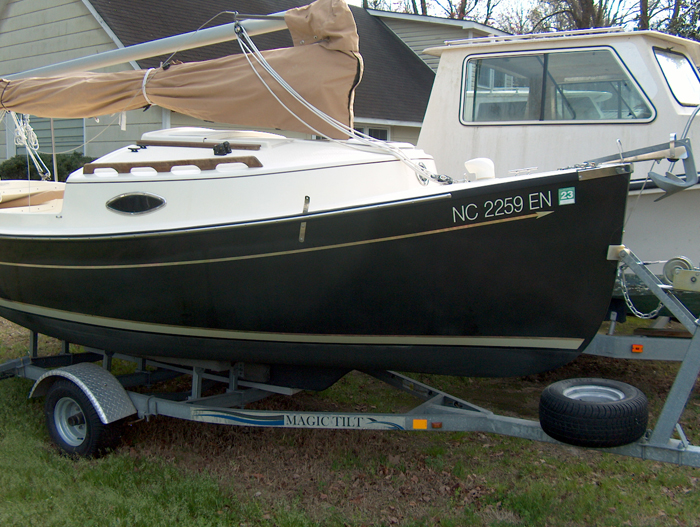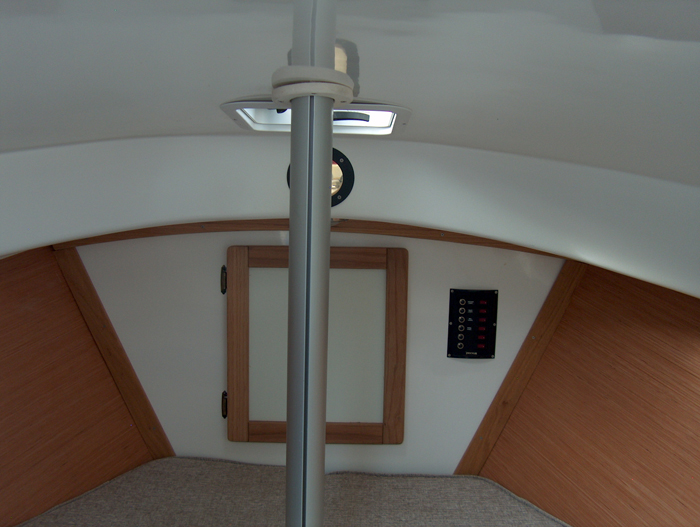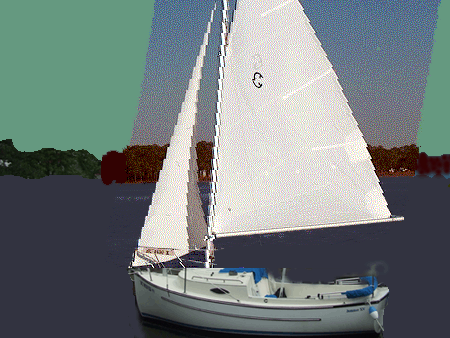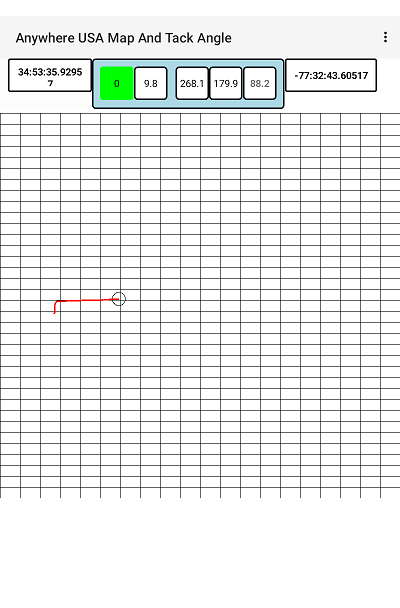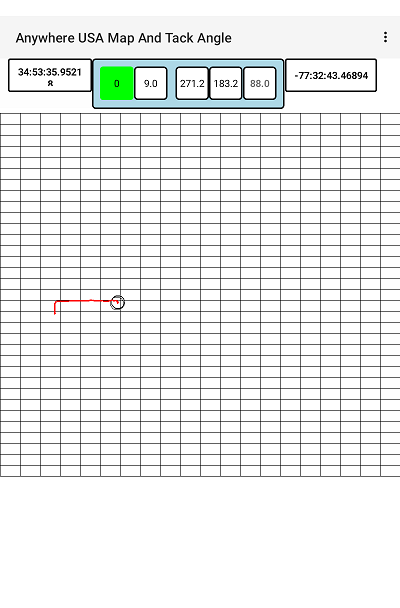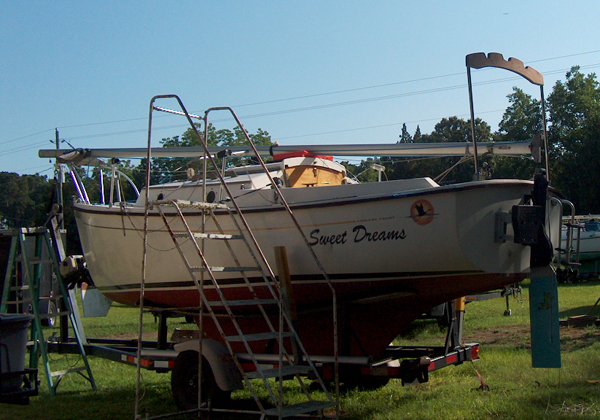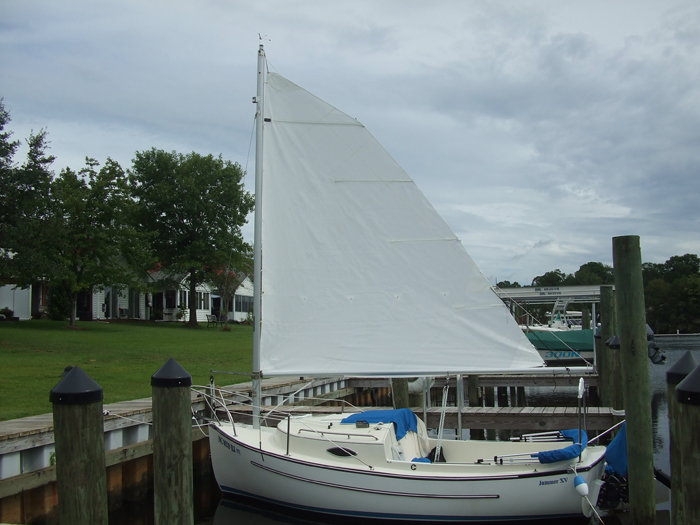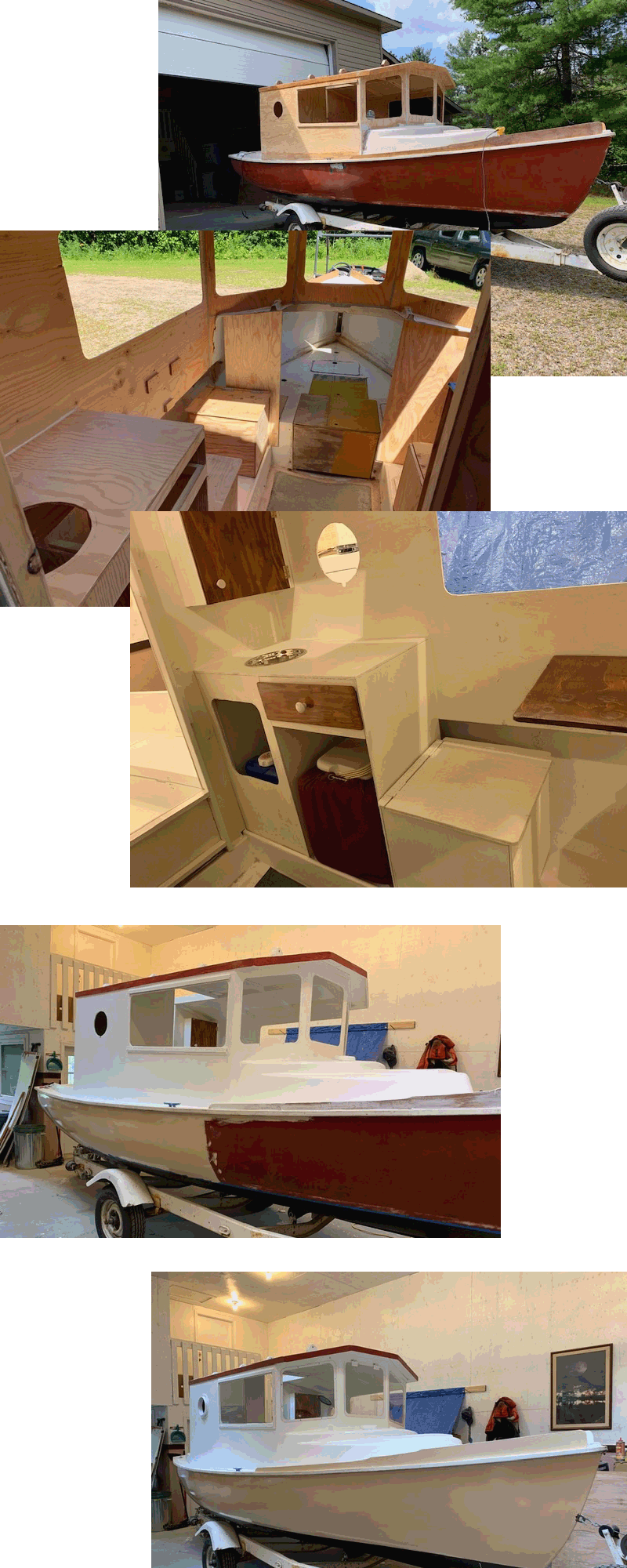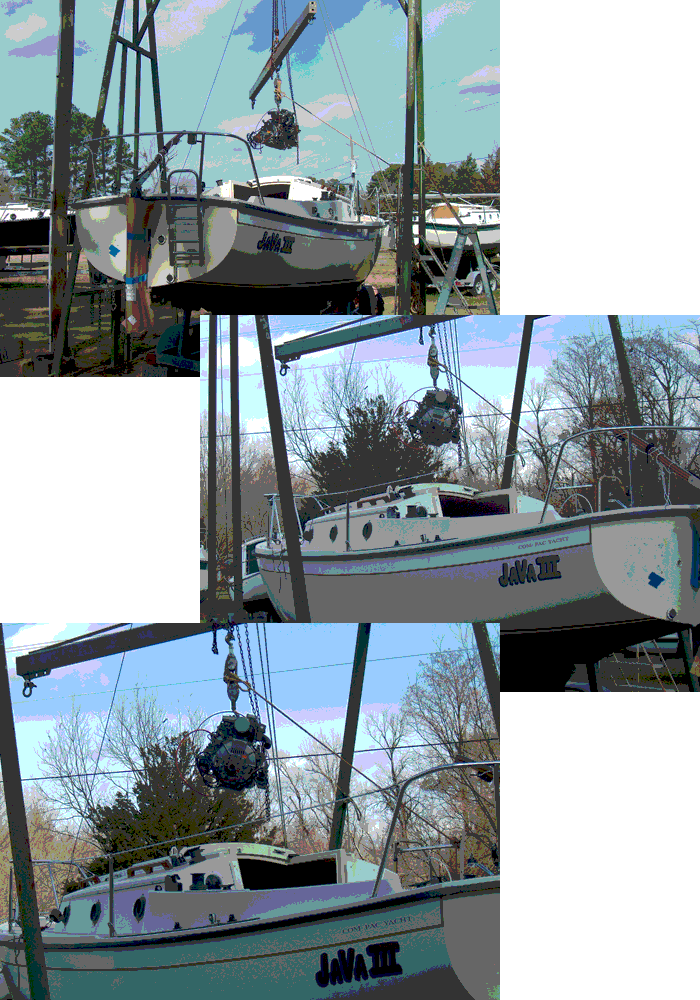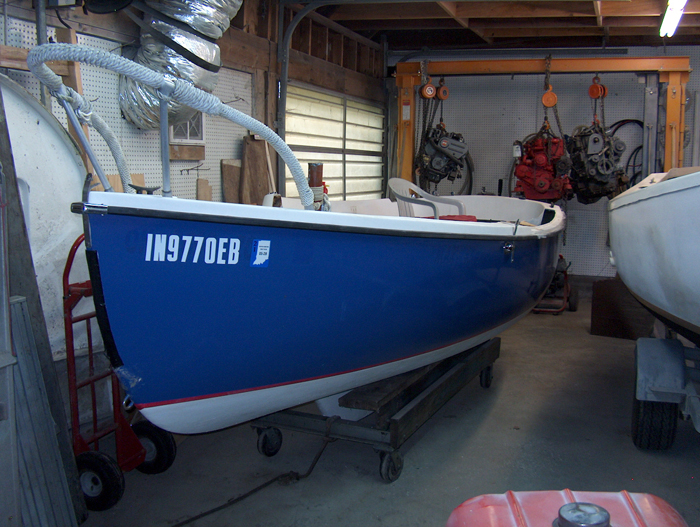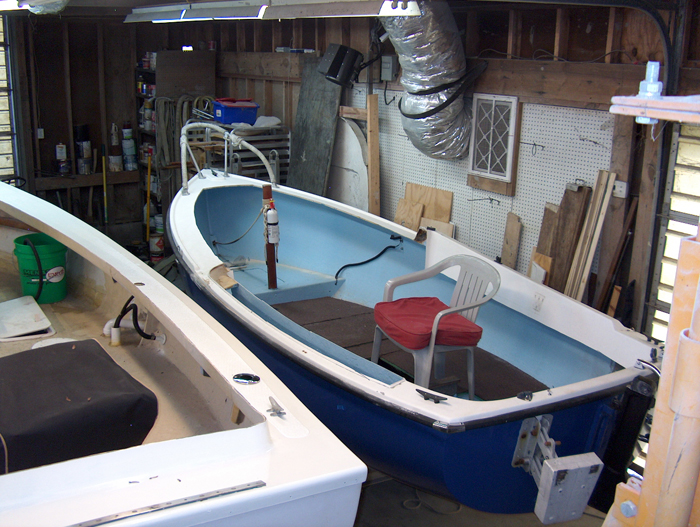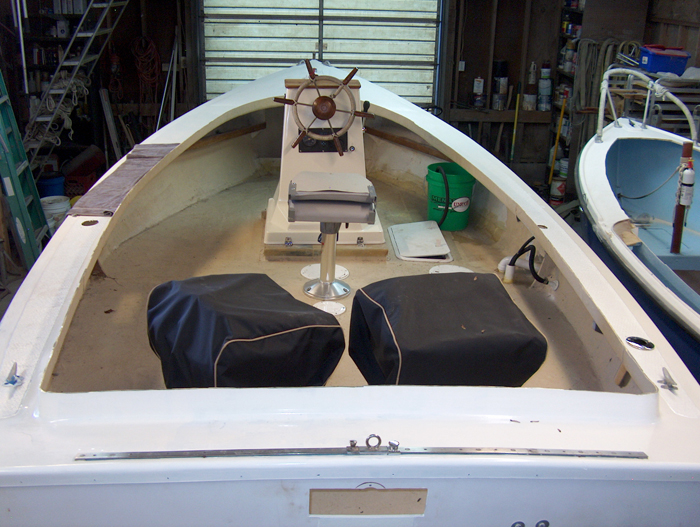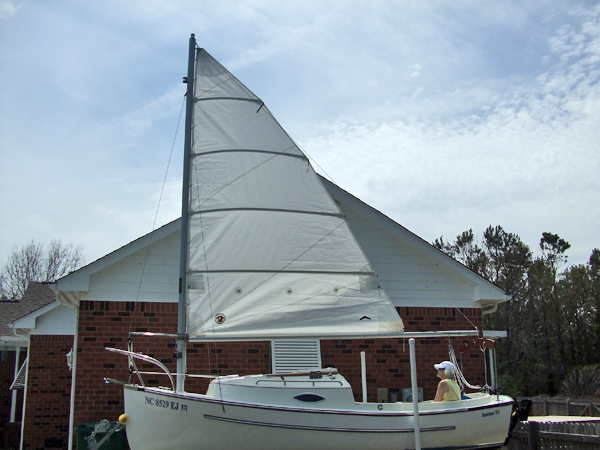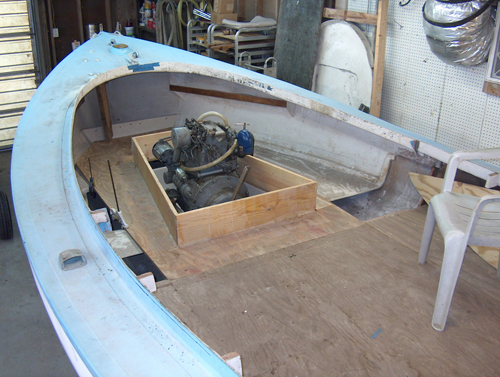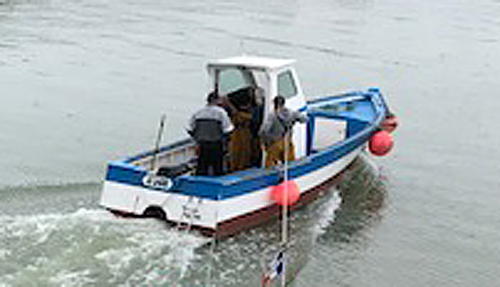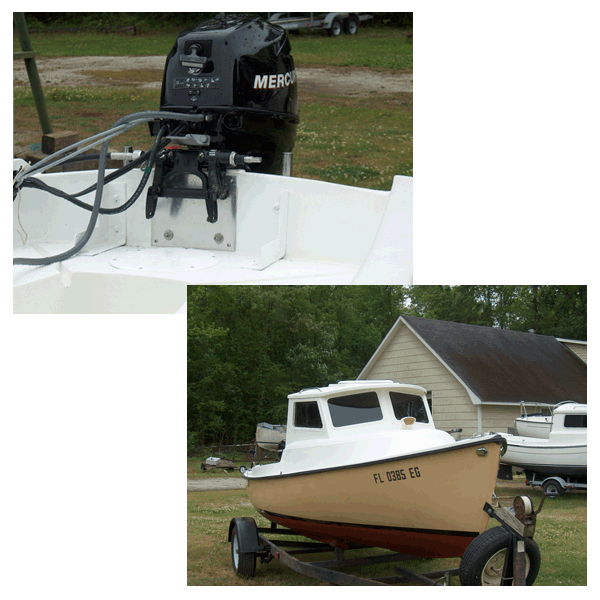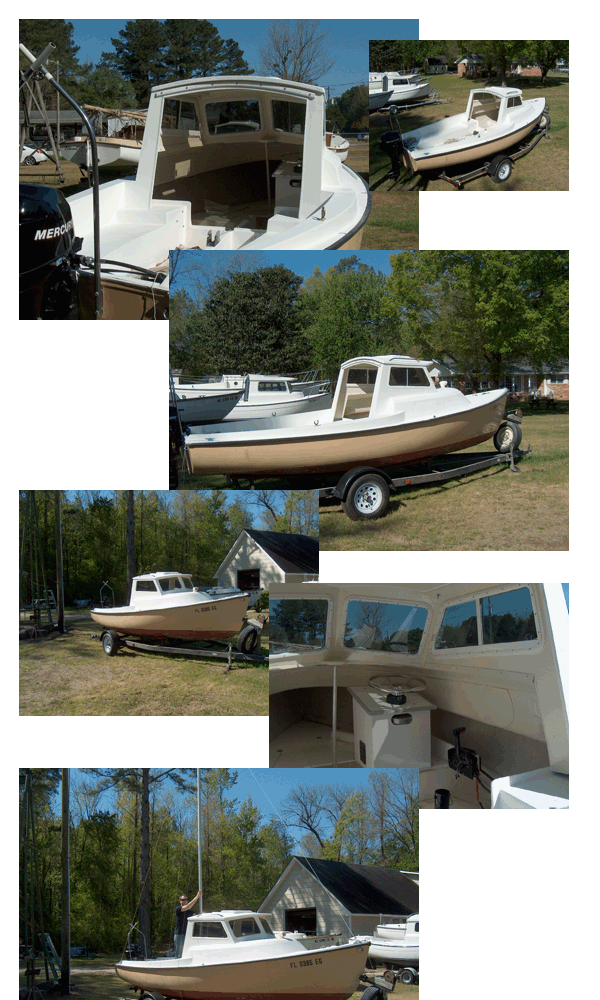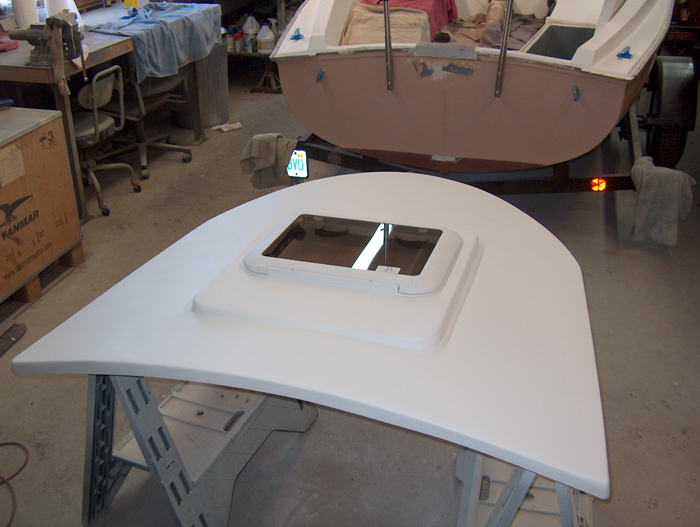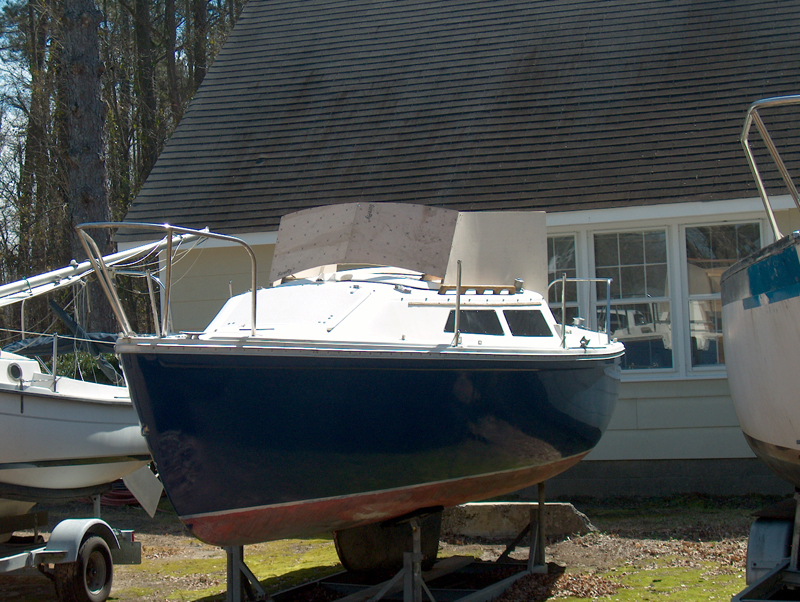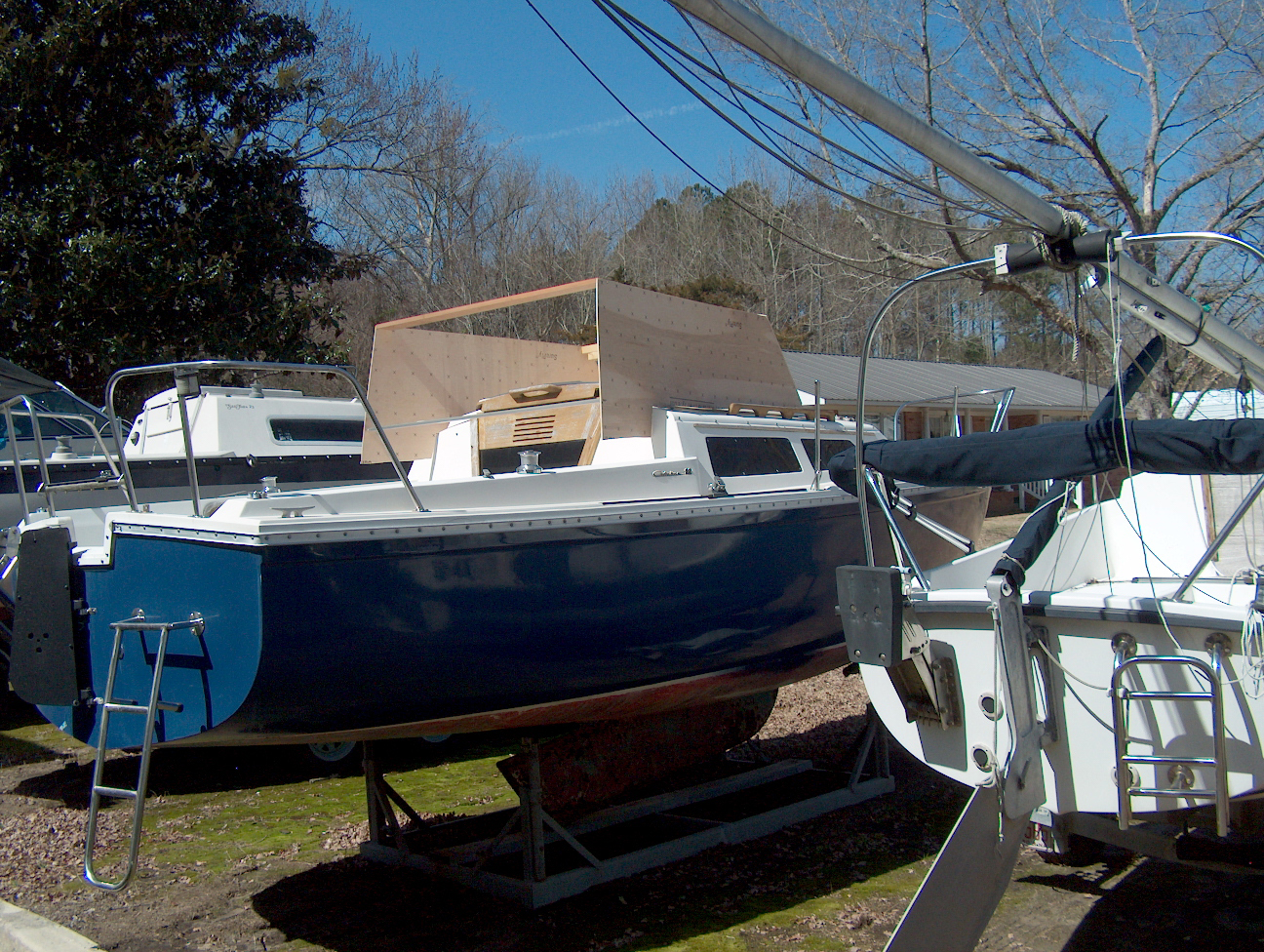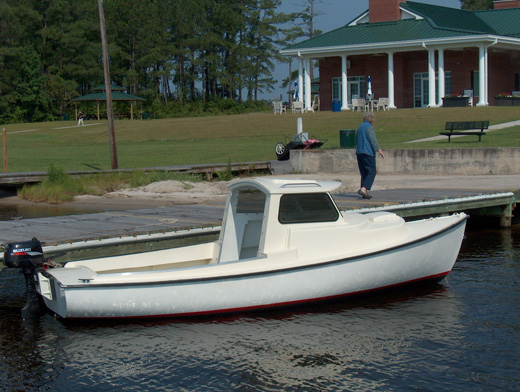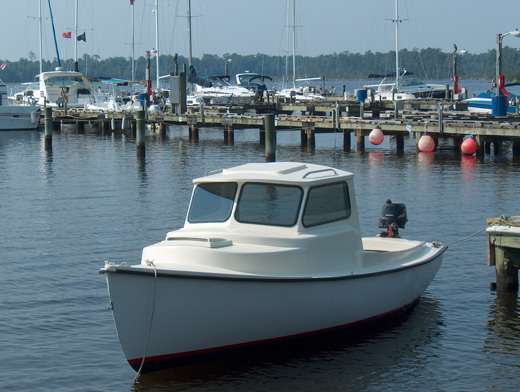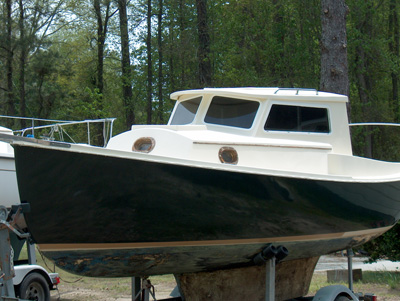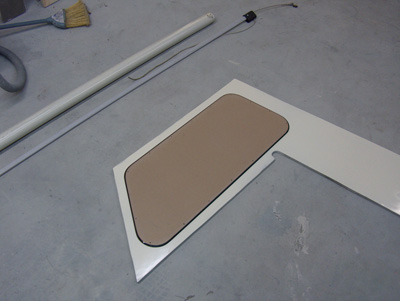We Are Building A New Boat:
The Com-Pac 16 Long Boat is going to be popular. It's going to have a variety of motors from diesels to oars. Not to mention sails. It may be even more popular than the original boat. The Com-Pac 16 were great boats, but they only did one thing and that's sail. The Long Boat and Skiff are going to be multi-useful doing many different things. Fishing, exercise machine and sailing are only a few. Maybe doing them all in one outing. We are taking orders.
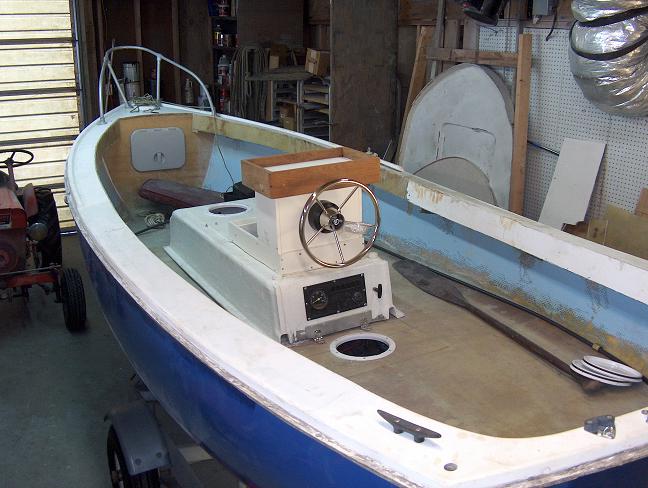
Why Should We Build A Com-Pac 16 Utility?:
I remember all those years in the Marine Corps when we were aboard ship somewhere in the World and we needed to go ashore. I was normally on an aircraft carrier and they are big and couldn't get to a dock for liberty call. We anchored off and had to take a small boat ashore if we wanted to get off the ship. After months at seas, everyone wanted to get of the big boat for a while. Those little boats were called Liberty Launches. They were wood, painted gray and they were heavy. They had diesels and they felt like a rock even in rough seas. Sometimes if you wanted to get back to the big ship, we had to repair the boats when and where they broke. I liked those Liberty Launches.
The Com-Pac 16 Utility is going feel like a Liberty Launch. The newest configuration is going to move the Center Console to the Option list and a standard feature is going to be a six-foot long seat setup long-ways in the middle of the boat. We will have more storage with the long seat. The boat is going to look a little like the boat on the front of the Jamestown Distributors Catalog below.
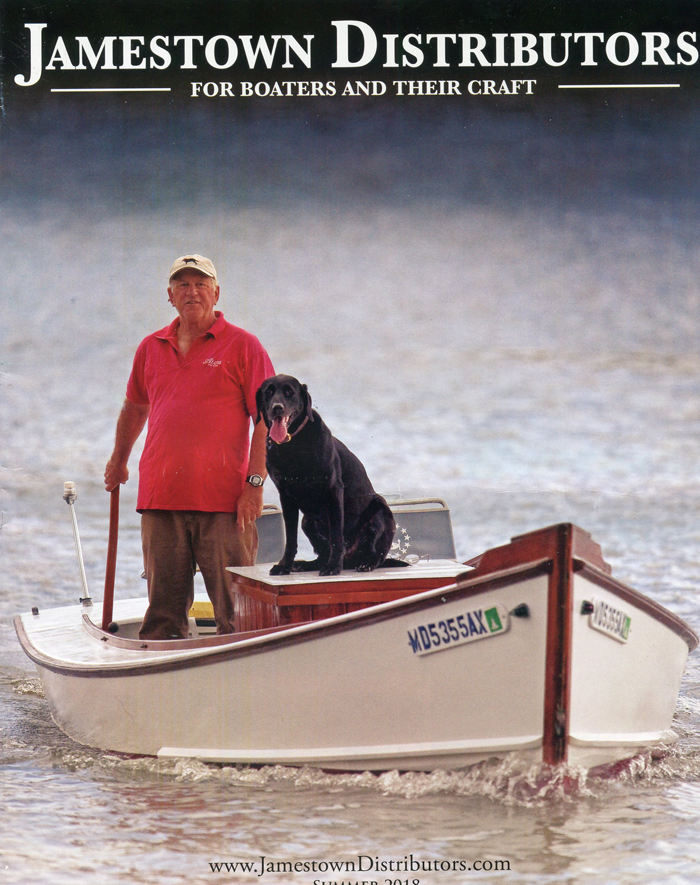
|
A Diesel For A Com-Pac 16 Utility:
The big question is can we pull water skiers with this boat? The answer is maybe. The little 1GM10 is only 160 pounds and it is sitting over the ballast. This boat might have a cover for the engine that's also a seat and we might keep the rudder and tiller as is. We might keep our center console we purchased for this boat for another boat. We were thinking that if we put the larger 15hp diesel in this boat, would it work? I think the answer is maybe.
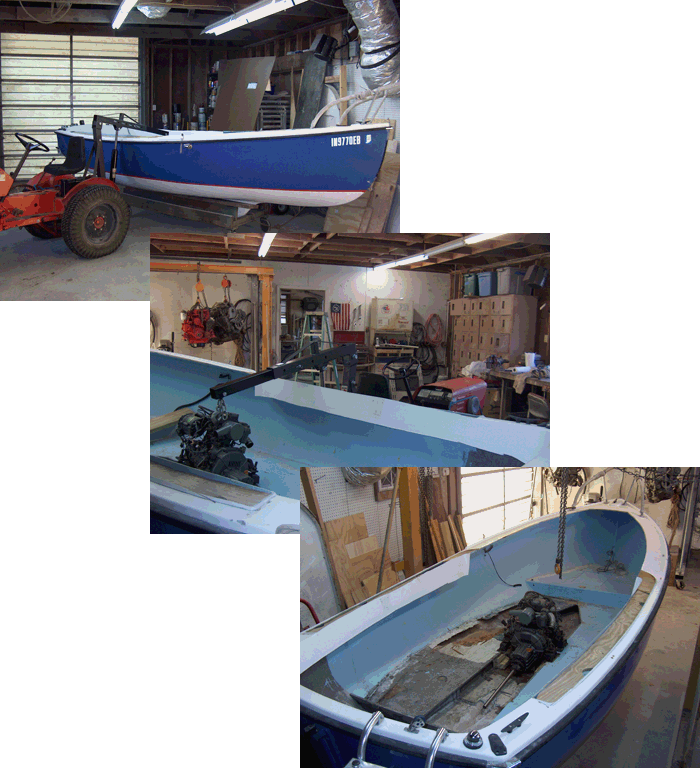
|
Getting The Mast Up On A Legacy:
I needed to take a boat to a show and I decided on a Legacy. I didn't remember that a Legacy mast was taller than our standard 16 mast. I needed to lift the mast several times to make adjustments. Picking up the mast wasn't fun and I decided I could use a mast raising system. I designed a quick one that uses a yoke and the trailer winch to lift the mast. The yoke stays in place while trailering and sailing. It works well, but I bet Gerry at Com-Pac could design a better one. I suggested he do so and sell it as an aftermarket installation. You can't leave the boom connected with the new system, but I don't think many people do that anyway.
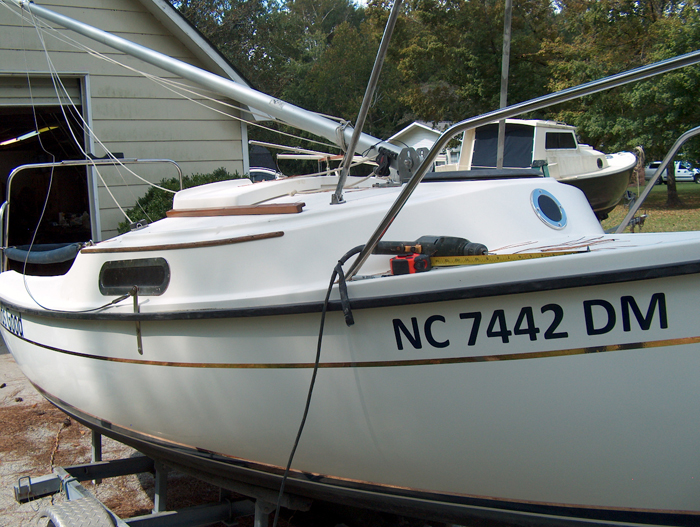
|
Cheap Fishing Machine:
We have been making some progress in all this heat. 97 degrees is hot and we have had too many days that hot this summer. Anyway, our converted sailboat is almost finished. It still needs to be painted and a bimini made for those hot summer days next year. I think we will do the paint job this winter. A black hull with a tan deck is on my list of things to do. We should be testing the boat in the water in August. We will take pictures.
Some of our older CP-16s with the wood cored decks are too expensive to restore. We are currently doing one of those boats as a center console like the boat below. It will have the console and we think a 9.9hp with remote controls. We will show pictures as we progress.

|
Lets Catch Fish:
Sailboats are complicated machines. They have all kinds of stuff installed to make them sail and then we add an engine that's makes more complicated. When they get old or damaged from hurricanes or what have you, they become junk. That's right, I said junk. It takes too much money to buy the new equipment and pay for the labor to put them back into almost new condition. We all like boats in almost new condition. So what do we do with all these fiberglass boats that are too expensive to repair. They get cut up and end up in a landfill. I think there is a better way for old sailboats to end their life. Why not make them into fishing boats.
Fishing is still the king of sports when it comes to using boats. We took an old 1967 Hermann Cat Boat that was too far-gone to refurbish. Old boats used wood for a core in their construction and that was a killer when it came to a long life. The hull was solid glass and was really pretty and good condition on this boat. We removed the cabin, centerboard and everything else that we didn't need. We installed a flat floor made out of plywood and Epoxy. You can square dance on that floor. We installed a hurricane-salvaged diesel in the boat and guessed at the right spot in the boat for good balance. We miss the mark a little and we are going to install a different lighter diesel to reduce the weight in the bow. You can see the prop in one of the pictures. The stern needs to be lower. We have a plan to add some weight to the stern. Stay tuned for the next changes.
I think there are lots of small sailboats that might be great fishing boats. If you know of a Catalina 22 that's out in the woods going to pot, you might to try making it into a fishing boat.

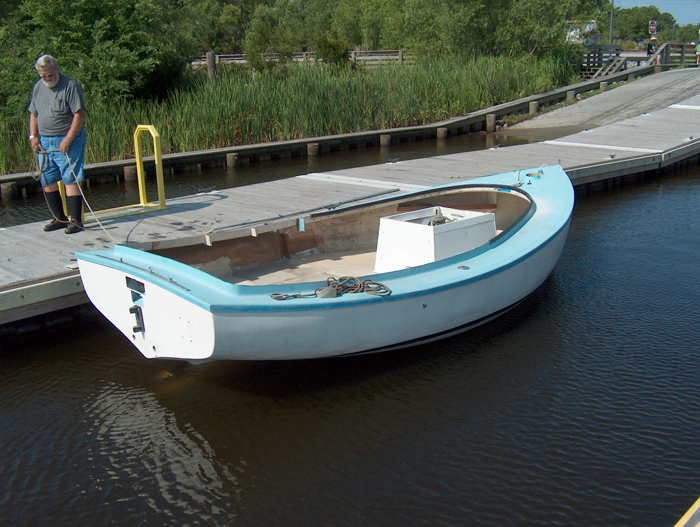
|
Who Said Com-Pac Didn't Make A Trimaran?:
We had a Hobe 16 that we were never going to sell. The boat was on a good trailer that could be converted to a utility trailer. The trailer got converted and works great. The hulls are sitting on the trailer in the pictures. Putting the Hobe hulls to good use is going to take a little longer. A trimaran can carry more sail and maybe go faster on most points of sail. We are also thinking of a larger motor for this boat. It just might plane.
The design so far features folding hulls on both sides of a Com-Pac 16 sailboat. We plan on having the Com-Pac Factory makes 4 stainless steel mast tabernacles for hinges. The initial leveling tests to determine the right position for the hulls when down and in the water will be automatic or self-leveling. Once we determine the right position for the hulls, we plan on securing them with stainless steel struts or wires. They need to fold up to go down the road and that should be easy with our basic hinge design.
We hope to test the first boat this summer. Trimaran # 1 is going to be fun boat to sail and a test vehicle for additional boats to come. Got your boat ordered yet?
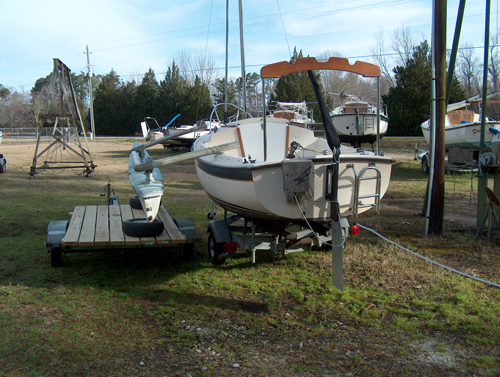
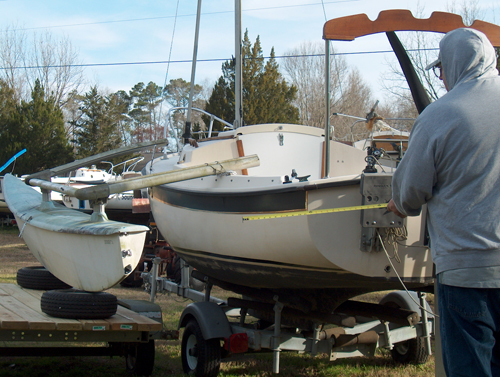
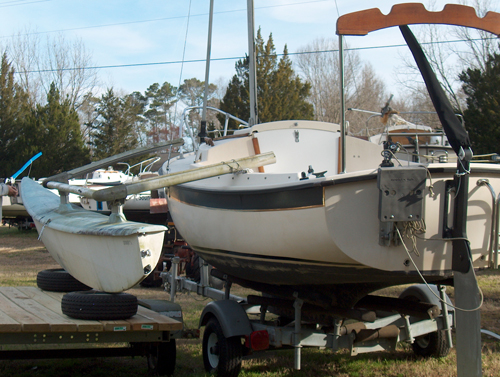
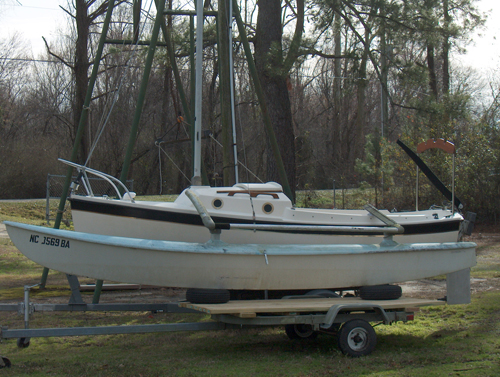
|
What's Next On My Project List:
Hurricane Florence slowed our projects down a little. You could say our current project is Florence and what comes after a hurricane. We just about have that problem solved and it time to get back to boats. We have been thinking about a Com-Pac 16 Trimaran. When you mary a Hobi 16 to a Com-Pac 16, what do you get? I think I'm going to get a boat that doesn't heel, carries more sail and it just might be a little faster. I have both boats available and we should see some results this summer.
The hard dodger for the 19s and 23s is still in progress. The phototype on my 23 withstood the hurricane winds. It is still in one piece. I plan on launching that boat this summer and the dodger needs to be working by that time.
The big diesel fishing boat built on a catboat hull is in the shop waiting on an epoxy deck coating. I'm waiting on warm weather to epoxy the deck and fill the centerboard slot with fiberglass. The Ground Hog in Pennsylvania said we will be having an early Spring. We can hope.
|
A Home For Our Big Diesels:
Our big diesels are not that big, but they could be smaller for a standard 23 or smaller boat. Maybe a project down the road will be a 25hp motor in a 23-foot boat. If we used a standard propeller on the boat, the boat will perform like a normal 23-foot diesel sailboat until the boat gets to hull speed. The engine speed will be low at that point. I'm guessing less than 2000 turns. Diesels like to run at between 2500 and 2800 rpm at cruise. This extra power could be available to pull or push other boats. If I was pulling a 30-foot sailboat with my overpowered 23-foot boat, the engine speed could very well be in the happy range for the installed diesel. A downside to the project will be finding enough room in the boat for the larger engine. Com-Pac is currently doing it with their 15hp installation in their Com-Pac 23 diesels. The 15 is over 300 pounds and as big as some of the used diesels that I have in inventory.
I currently have a used 23 Trawler that's very cheap. It needs a new house and other improvements. It has windows that look like they were made for a tug. It might be the perfect boat for this project?
|
A Hard Dodger For The Com-Pac 23:
A hard dodger is not the best solution for sun shade on most small sailing boats. They get in the way of doing what's required to day sail most small boats. However, if you are cruising your boat and going places, a hard dodger might be just what the doctor ordered. The one below is shown on a power launch. We are currently building the launch on a Hermann Catboat hull. The dodger will have fixed front windows with canvas side curtains. The cost is going to be reasonable.
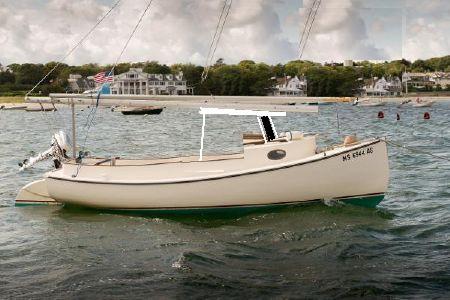
|
The Com-Pac 23 Is Becoming Trailable:
Maybe the best boat for an experienced sailor might be a Com-Pac 23. Big boats require lots of work and they are best used as charter boats where more than one couple can share the work and the expenses. The 23 has become more portable with several different mast raising systems that really work. Getting the mast up was a limiting factor in the old days. Several owners have made big improvements to their boats recently in their driveways. They buy an old boat cheap and put new everything in and on the boat. The end cost isn't cheap, but the results are worth the cost. A refurnished boat should cost about half as much as a new boat not considering your time. The Com-Pac 23 is one of the best boats ever built that can be modified and improved by its owner. The wood interior lends itself to easy modifications by owners.
The trailer is going to pay for itself because you don't have to pay slip rental fees during the wintertime. We recommend getting a good trailer and not trying to save money on this accessory. The motor can be an outboard and we like a 5hp or 6hp motor. Larger motors can't slow down enough to maneuver in marinas. The 23 is also an excellent boat for a diesel conversion. We once made the journey from Silver Lake on the Outer Banks to New Bern in 14 hours. We averaged 6 knots. The boat can be converted to a pilothouse model with standing headroom. It can also be converted to use a 4-stroke outboard in the middle of its transom with an attached rudder under the hull. All of these modifications mean that you can customize your boat for your sailing style.
Taking a pilothouse 23 to Florida in the winter for a few weeks may be as good as it gets. It's 25 degrees outside as I write this article. I think I might go to Florida in 2018.
We are currently building a Com-Pac 23 Pilothouse with a 9.8 hp Tohatsu motor. We are
using the large engine because it was available and it has remote controls. This boat
will have inside and outside steering. It's a 2-person boat for sleeping and 6-person
boat for daysailing. The boat will be equipped with mast raising and jib furling
systems. Small diameter tires on the trailer should help getting on and off the boat
while it's on the road. It will be a camper when it on the trailer and a sailboat when
it's on the water.
|
Lets Create A New Boat, Maybe?
Most people don't know that Com-Pac built catamarans several years ago. Back in the old days, catamarans were excellent charter boats and Com-Pac though they might get into that business and sell one or two to individuals. The individual s sales didn't pan out because the boats cost too much. The production cost of a catamaran is really the cost of two boats with the individual only getting one boat. Now may be the time to try building a Com-Pac Trimaran. Com-Pac has their hands full building their current line of boats, but maybe The Sailboat Company could build an aftermarket boat and do it with used boats? A used Hobe Catamaran isn t worth much on the used boat market. If we could combine a Hobe with a Com-Pac 16, I think we could make a Com-Pac Trimaran 16.
Hobe Catamarans use mast extrusions for structural members. I think we could order four short Com-Pac 23 mast pieces (six foot lengths ship UPS) and use them to support the Hobe hulls or wings. The wings would hinge up and over to reduce the Tri's width for roadwork and launching. So much for the construction.
What are the differences between a trimaran and a standard sailboat? The trimaran sails more upright because of its greater width. It can carry more sail area for the same reason and in most cases, a tri is faster. They don't tack as well as a standard sailboat and they can be hard to manage at docks. We really don't know how well they will work until we do one and that may be sooner than we think. It's going to be fun.
|
Restoring A Nimble Kodiak
Every boat needs to be restored at some time during its life, maybe more than once. This was the right time for this Nimble. It had had three owners up to now and it had some minor damage and normal cosmetic issues. Jerry Koch in St Petersburg, FL built this boat in 1994. Jerry was a craftsman that created several boats that were unusual to some people and beautiful to others. I remember selling a new Nimble 20 to a Canadian citizen. It was the only tan colored Nimble hull every built. This was also an unusual sale in that boats normally go the other way. We buy Canadian boats because there isn t any import tax on boats coming from Canada and boats going to Canada are just the opposite. Import tax on a boat built in the United States and going to Canada is very high. It s like a one-way road going to the States. The Sailboat Company traded a good-looking Kodiak in great condition for a little money and this Kodiak in poor condition. The good-looking Kodiak also had some accessories that were desirable items for the new owner. This is how our Kodiak in poor-condition started on it s road to recovery at The Sailboat Company.
We started making our list and it was extensive. The major items were: The teak and holly floor was damaged and had to be replaced. The diesel engine had cooling water issues and that problem had to be solved. The main cabin windows leaked and that problem had to be solved. The inside varnish around the helm was damaged and that had to be refinished. Like all green Nimble that used gel-coat for a finish, the hull needed to be painted and new stripping added. The main hatch was poorly designed and needed to be replaced. The boat was originally configured as a trawler and we were going to convert it to a pilothouse. We were also going to install an electric icebox and a marine head. The boat originally had those items and the third owner had them removed.
The origin of the Kodiak model was the little Nimble 20. Back in the 1980s, boat builders in FL were using lots of imagination to come up with sellable products to satisfy the demand for recreational sailboats. Jerry Koch was building the Nimble 20 and 30 at that time. The 30s were conventional looking sailboat. He wanted to expand his line of boats and he decided the best way to that was to cut a Nimble 20 into two pieces and put it back together with a new middle section. The new Nimble 24 grew in length and width with that modification. He also increased the height of the hull to give the boat the right portion. The boat looked good and it was big. The Nimble 24 sailboat became the base boat for all the other trawler and pilothouse boats that were to come later. This was during same time period that Bob Johnson of Island Packet was building his first boat. Bob had worked for Ted Irwin as a designer before going into business on his own. Com-Pac just created a new boat, the Com-Pac 19 designed by Bob Johnson. It was a great time to be in the sailboat business. Lots of builders and vendors produced lots of competition that reduced the price of sailboats.
The teak and holly floor had to be replaced. What caused the water problem was a cockpit floor hatch that wasn t correctly secured. Fixing the leak was easy, but fixing the floor would be difficult. Removing the teak and holly that had been glued in place was time consuming. After the teak and holly was removed, some type of finish had to be applied for cosmetic purposes. We are debating the merits of tile, tuff-coat or gel-coat. This will be one of the last items that we will do before the boat is finished.
Trouble shooting the engine-cooling problem was easy. The intake through hull was kept closed and that allowed water creatures to build a nest next to the closed through hull. Blockages are common on little used engines. Cleaning the blockage solved the problem. Another engine problem was access. Getting to the dipstick on the starboard side of the engine was difficult. We cut an access port on that side of the cabin to provide access. The cockpit hatch that caused the teak and holly damage also reduced the strength of the cockpit floor. The cockpit floor will need to be strengthened. We have several plans in mind. Also the cockpit floor is extra deep. The distance from the seat to the floor was too large. That might have happen when Jerry increased the height of the hull on the Nimble 24. A wood grate that has extra thickness might help crew moving around the cockpit.
Making a hull paint job quick and easy has always been a problem. Spray painting with Al-GRIP paints can be dangerous and requires lots of time and preparation. It kills the shop for any other kind of maintenance for several days. Our paint procedure on this boat is TIP and ROLL. The results have been outstanding using two-part Perfection paint. We are painting the Kodiak hull black. Black is the most difficult color to paint and it is doing well. Of course the problem with the tip and roll painting method is the possibility of brush marks. Sometimes we get them and sometimes we don t. A great thing about the paint is that it can be sanded and buffed after it gets hard enough in about two weeks. If you get brush marks, you can sand and buff and the shine will come back almost like it was before. You can see that repairs are going to be easy to do when needed. Using this method prevent us spending time covering the rest of the boats and everything else in the shop to prevent over spray.
Leaking side windows on Nimble Kodiaks are well known. The problem is that the right hand didn t know what the left hand was doing. The Kodiak deck is laid up as a whole laminate. The house and the deck are really one piece. The fiberglass people that laid up the laminate didn t see a need for extra glass in the vertical sections of the house. The vertical sections normally don t provide any needed strength to a laminate. In this case, the vertical sides needed to be thick enough to secure and seal the large windows. The glass was too thin to hold the large heavy windows. This appears to be a common problem in all Nimbles with large windows. They all leak and the inside furniture becomes ruined. We are using a two-inch aluminum flat extrusion on the outside to strengthen the joint between the window frame and the glass. The extrusion seals and makes the joint rigid using black 3M5200. We currently have a dry boat.
The main cabin hatch was a see-through Bomar hatch. It was hard to lift and had a mind of its own about staying open. Of course the pilothouse modification needs to have the boom move in that area when the hatch is open. We had a spare Com-Pac 23 hatch cover that was available. I really like sliding hatch covers anyway, so we designed what we needed to facilitate the new hatch cover. It s going to look and work well. It s a winner to my eye.
Now we can go to the most interesting part of this project. We have a Kodiak trawler, a Catalina 22 mast, a Com-Pac 23 pilothouse mast pedestal, a Com-Pac 23 boom and set of Com-Pac 23 standing rigging. We have lots of used sails, so sails will not be a problem. How can we put it together to make a sailboat? We checked the mast base and it fits the tall mast pedestal that s needed to install a mast in front of the house. The chain-plates for the shrouds will be the Kodiak toe rail or we can always install real chain-plates if needed. The Catalina mast is taller than a Com-Pac mast and with the Com-Pac standing rigging, the Catalina mast may need to get shorter although taller is better to get more mainsail over the house. The idea will be to use the rigging without modification. That will make the furling gear usable as is without modification. We are considering a factional rig configuration with the longer mast. One additional consideration is that the original Kodiak pilothouse has more draft and a little more ballast than the trawler version. I don t think too much canvas is a big problem, but over canvassing a more shoal draft boat with larger sails isn t a good idea.
We are living in a golden age. Restoring small old sailboats that were well built back in the 1980s with all the parts and pieces that are available today is both fun and practical. You can design and build your own boat for pennies on the dollar. I would like to put extra emphasis on the word small. The larger the boat, the more difficult restoration becomes in time and money. Large junk sailboats were being purchased at one time for the lead in their keels. The price of lead is no longer high enough to cover the cost of removing and selling the lead. I m not sure were all the current hurricane boats are going to go. The small ones will live again.

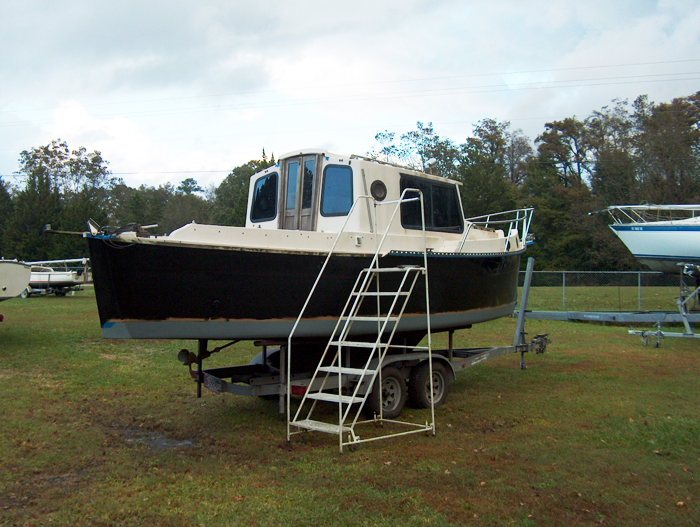
|
An Old Sun Cat Lives Again
The restoration business is really interesting. Boats normally come to us to be repaired and we end up buying a boat that a customer doesn t want to pay to have it repaired. Our Clark Mills 1979 Sun Cat came to us that way. The customer said the diesel engine needed something and we were the only marine diesel mechanics close to his location. He had to drive the boat and trailer two hundred miles to have us evaluated his engine. The bad news on the engine was that it needed to be rebuilt. He didn t want to pay the estimated $3,000 for an overhauled engine so he sold the boat and trailer to us.
There were boats built in the 1970s that were quality boats. What we had back then was more time and expertise to do quality woodworking with heavy fiberglass construction. Build time and the money spent on a boat are really the same thing. This boat would be too expensive to build today. Not every boat builder created great boats and those boats are long gone. The quality ones that didn t meet some disaster along the way are still with us.
This boat was an early Clark Mills Sun Cat with a long bowsprit, a wooden gaff mast and shoal keel. After doing our research, we determined that the boat was originally built with a gasoline engine back in 1979. The boat was restored in 1998 with a new diesel engine, Al-Grip paint and new inside cushions. It spent most of it life in Connecticut under covered storage during the winter. A bad impellor and no cooling water caused the engine to fail. The boat was sitting on a cradle with a bad engine during Hurricane Sandy and did have some interior flooding. The flooding was fresh water and did little or no damage to the boat and only minor additional damage to the engine. We think someone purchased the boat from an insurance company and didn t know the engine was damaged. He or she also purchased a new trailer and took the boat south with the idea of sailing the boat on Lake Murray, SC.
After evaluating the boat, trailer and engine, we came up with an estimated cost. The minimum cost was just an engine overhaul. We estimated $3,000 to remove repair and replace the engine. The owner wasn t interested in restoration that would have included the boat and trailer. The boat s wood mast limited the boat s use to a boat in a slip. The boat couldn t be launched from a trailer because the mast needed a crane. Our solution for the mast problem would be to convert the wooden mast to a more modern configuration. The trailer had to be adjusted to fit the boat and make it suitable for launching a boat. The boat needed to be moved on the trailer and the bunk and keel boards had to be replaced. We didn t do a cost estimate for a complete restoration because the customer didn t want it done.
With the owner not interested in having the boat repaired or restored, we purchased the boat and started our restoration. The Sailboat Company restoration list included rebuilding the engine, replacing the wooden mast with a Com-Pac Horizon Cat mast, sail and rig, repairing some wood rot in the bowsprit, refinishing the teak toe rail, new bottom paint and new canvas. We also needed to modify the trailer to make launching the boat easy. The headsail was going to be a furling sail with remote controls. The cabin interior would also need some cosmetic improvements. Of course the boat needed lots of cleaning and polish.
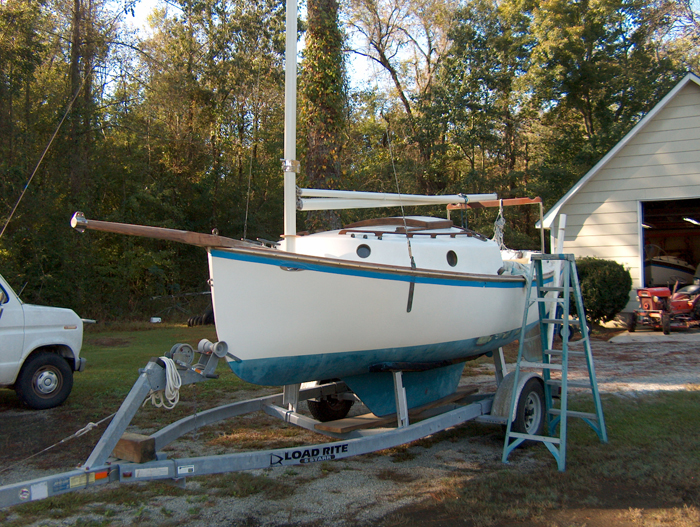
We started restoration with engine removal. During removal we noted the engine accessories were different than most installations. We also noted that the engine was a 1998 model. The water strainer, fuel filter and stuffing box were much older in design and function. Access to some critical components were almost impossible to reach. As we removed the engine, we commented that who ever installed it must have been a very small person.
What identified this boat, "as up north boat", was its three deck pick-up points that were originally installed when the boat was built. There are very few launching ramps in our northeastern States. The tides normally prevent boats from being launched from boat ramps. The sailors in those areas use cranes to launch their boats and built-in pick-up points are typical accessories on their boats. This boat also had a drain plug installed in the keel, a manual bilge pump and didn't have an automatic bilge pump. The reason for drain plug could have been to easily drain water while the boat was on dry land. That would have saved pumping the bilge dry with the pump. I think the reason the boat didn't have an automatic bilge pump was because the boat didn't spend any time at a slip or moored at a buoy. It needs one now and one will be installed.
The engine looked good on the outside with little rust and good paint. That normally means little use and low hours. On the bench, we removed the valve cover and the overhead valve lifters to give us access to the head bolts. We turned the crank with the lifters off the head and the crank still stopped at the same spot. With the lifters off the head, all the valves are closed so the problem couldn t be valves striking a piston. The next step was to remove the head and see what was going on below the head. After removing the head and chipping some ash off the camshaft, the crank moved correctly.
What happened to the engine? The engine was run with a bad impellor and overheated. The overheated head cracked at the exhaust port and let small amounts of exhaust ash drop down into the push rod follower. When the engine was intact, turning the crank caused the camshaft to rotate to a point where it needed to push the follower up and couldn t because ash was blocking the follower's movement. The engine was going to need a new follower, push rod, and a new head with new valves, overhaul gasket set, impellor and a new starter. New heads come complete with new valves and springs. The starter had been damaged by water being in the starter for a long period of time after Sandy. A new starter was cheaper than rebuilding the old starter. Everything else on the engine checked out OK. The engine looked almost new on the outside and also on the inside. Someone had been changing his or her oil on a regular basis. All the consumables were renewed and the engine was run on our test cell. The test cell results showed a smooth engine that started and ran well.
It appears that all 1GM10 heads crack at the same place. We have had several heads crack from overheating and one cracked from freezing. Where the exhaust pipe connects to the head is the exhaust port. The head casting at that point has three things going on at the same time. It has water in the head for cooling and a cavity for the push rod to function and the exhaust port itself. All three are only separated with thin pieces of casting metal. If the water freezes, it cracks the metal. If the water is absent with no cooling, it cracks the metal. The Achilles Heel of the 1GM10 is the exhaust port head casting.
The Com-Pac Horizon Cat rig plus a jib will make this boat a little over-canvassed. However, it should handle windy situations well with a reefed mainsail or no jib. It should be perfect for lakes that have light wind conditions. The idea was to make the boat portable using a trailer. It will have a mast raising system that will make it easy for one person to handle. I could have installed a Sun Cat rig on this boat, but that wouldn t have been as exciting or as versatile as the Horizon Cat rig will be.
At this point in our restoration, we can say that this boat is well built. Apparently, 1979 was a good year for heavy construction. The wood trim journeywork in this boat is exceptional. This type of construction may no longer be available anywhere in the World. Whoever Clark Mills hired back in 1979 to do his fiberglass work knew what they were doing. The reason I know is that I purchased a similar Sun Cat from Clark almost 10 years after this boat was built. The glass wasn t as good or as thick as the glass in this boat. The cabin wood decoration in the newer boat was better. The old boat is a little plain but very functional. We will do our magic on the interior before we finish the boat.
The boat has some beautiful teak louvered hatch doors. The plan is make canvas covers for the doors. The boat has an autopilot and a depth sounder and they will be checked for satisfactory operation. All the running rigging will be operated from the cockpit. I think this boat will deserve a carport or a garage for storage when it s finished and it's not on the water sailing.
Picture of sister ship below:
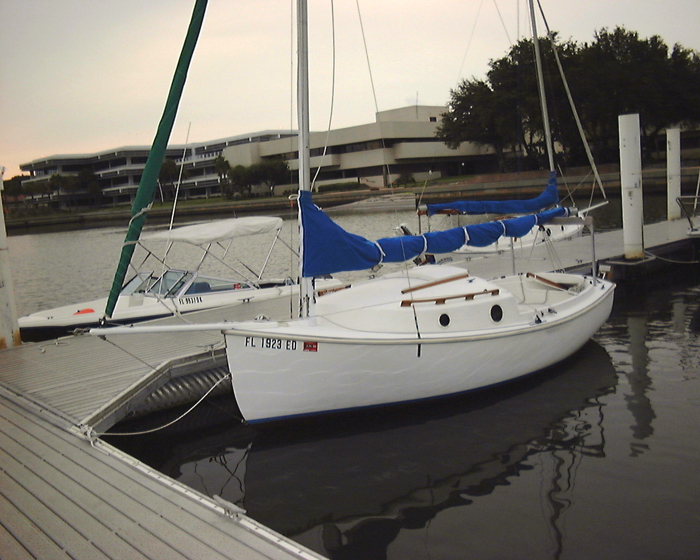
|
Com-Pac 23 Mast Raising System
We all know that the Com-Pac 23 would be more popular if one man could raise the mast easily. Just think of going places and having a Com-Pac 23 to sail and sleep on. They are easy to trailer, but that mast can be a problem going up and down. Raising the mast with our Dealer installed option will make the 23 a better boat. Some sailors might do their own by figuring out the details of the picture below. The option is cheaper if the boat has halyards aft installed.
Any questions should be addressed to The Sailboat Company by email.
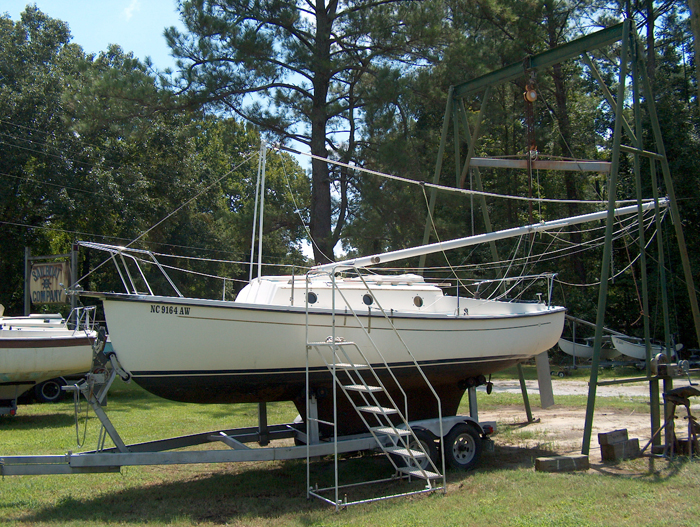
|
Com-Pac 16 Mast Raising System
A Mast tender Plus system for the Com-Pac 16 is a cool idea. Everyone really likes the system on the Sunday Cat. Being able to raise the mast with one hand or go under bridges at will is a handy feature. Some of the components of our Mast tender Plus system are a teak gallows, a stainless steel yoke, a rigid mast that doesn't move from side to side and a block and tackle system inside the boat. Com-Pac developed this system for the Sunday Cat, but it was so popular that most of the other catboats in the family get it installed as an option. After using it on a Sun Cat, we decided the 16s could use the same system.
Any questions should be addressed to The Sailboat Company by email.
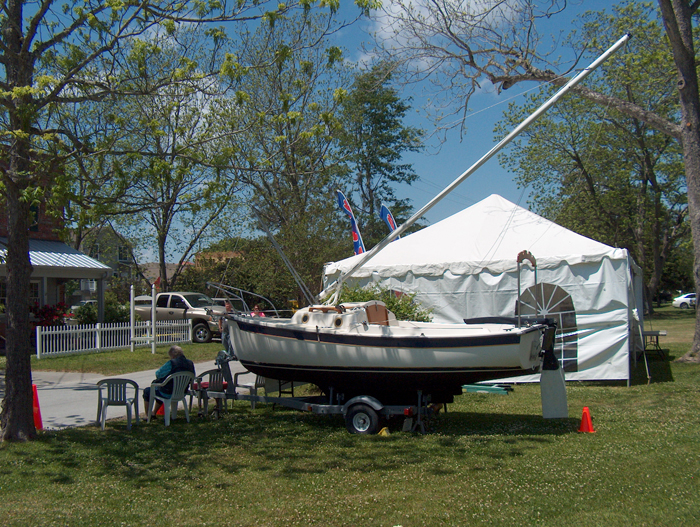
|
Teak Boom Gallows Installation
Com-Pac 16
The parts contained in the gallows kit are as follows:
1. Teak gallows board
2. 2 base stanchion poles, 1 inch
3. 2 stanchion upper supports, 1 inch
4. 2 splice tubes, 7/8 inch
5. 2 rings, 1 inch
6. Screws, 6
Parts required and not supplied.
1. Tube of West System Six10 Epoxy Resin
2. Glass cloth
3. Quart of Epoxy Resin
4. Application bush, 2 inch
5. 3M5200
Tools required and not supplied
1. Hole saw, 1 inch
2. Hack saw, fine teeth
3. File, fine cut
4. Level, 3 feet long
The boat should be put in a level position. That position is determined by using a level on the seats. Make the seats level from bow to stern and side-to-side. Jack stands under the trailer will accomplish this task. Take the gallows board and lay it across the back of the boat. The stanchions will attach to the end edge of the board. You are going to use the board as a measurement tool. Mark the boat where the center of the stanchions will enter the boat. The stanchions should be in a position that s balanced from side to side. Cut a hole 1 inch in diameter on both sides. You may have to file the hole a little larger to get the bottom poles through the holes. The pole bottoms are cut with a bevel. This bevel should come close to the joint between the vertical transom and the bottom of boat. The poles should fit tightly in the deck holes and rest on the bottom. The bottom should be marked with a pencil or pen and the surface sanded in preparation for the glass and epoxy application. The next step is the alignment step. Using a level, make the poles perfectly vertical. You can use string to pull the poles into this position if required. It s important that both poles are the same height from the deck to the top of the base pole. Cut small stripes of glass and soak them in epoxy. Lay the glass stripes around the base of the poles in a smooth manner. Remove the strings and any thing else that was holding the poles the following day. The base poles will be locked into position. The sealing rings go on next. Apply 3M5200 around the joint between the boat and stanchions. The welding joints on the rings will need to be filed down to smooth to make the rings fit. The rings are used to make a smooth joint and hind the caulking. We use epoxy paste inside the tops of the base stanchions to hold the splice. Put paste inside the tube and push the splice down to the half way point. Test the teak gallows board on the installed stanchions. They should fall into the same end points that were previously measured. If not, the upper stanchions position can be adjusted before they are screwed to the board.
The end height of the gallows can be adjusted by cutting the upper stanchions to a smaller length. That s why the splices are epoxies to the lower stanchions.
Any questions should be addressed to The Sailboat Company by email.
|
The answer to the question in the last project paragraph is the upper left engine is a new engine. The upper right engine is a stored engine. The lower left is a rebuilt engine and lower right is a broken engine. We want to talk about the new engine today. It's the replacement for the broken engine. We just put the new engine in a Com-Pac 25 that's in the water on a sound next to the ocean. We have about a 3-foot tide at the customer's dock. You might ask why we didn't do the change at a marina? A good marina was a long ways off and getting there without an engine would have been difficult. The added cost of doing it at a marina was also a factor. A complication in this project was that the old engine was going to be replaced with a different model engine. The old engine could have been repaired and put back, but the customer wanted more power and a fresh water-cooled engine. He has a salt problem being next to the ocean. Getting the old engine out was the first task and we accomplished that in one day. We used a block and tackle and the boat's boom to lift the engine and a board between the boat and dock as a bridge to push the engine to the dock. A handcart moved it to our truck and away we went. The old engine weighed 160 pounds. The new engine was installed in the main cabin the same way. It weighed in at 225 pounds. Not as easy, but we are strong and we lifted the new engine with two men. Changing models meant that we would need to make an adapter plate that would match the old mounting bolts with the new mounting bolt pattern. It wasn't easy. You can see the adapter in one of the pictures. The starboard side of the boat liner is position several inches to that side of the boat to accommodate the kitchen sink and counter. Back in the old days, the boat leaned a little to starboard in a slip and I had to install a second battery on the other side to compensate. That same problem complicated this installation. We have enough room on the starboard side of the engine (the shaft determines the center-line of the engine), but the engine is too close to the cabin structure on port side. We will have to do some magic to make that side work as designed.
We ran the rebuilt engine on the stand that you see in the picture. Provide water, fuel and a battery and an engine will run well in the shop. We try to remember to put the exhaust outside so the shop doesn't get too wet. We replaced the head (it was cracked from being run without cooling water). The broken engine froze the one night we had 28 degrees on the beach. I'm guessing that it will also need a new head.
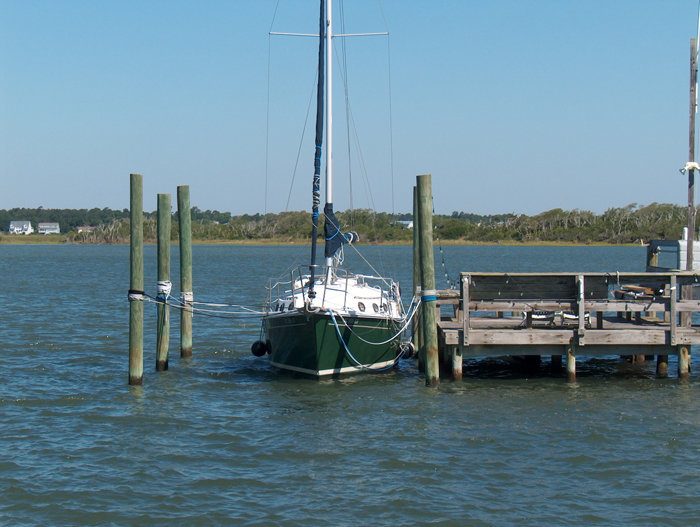
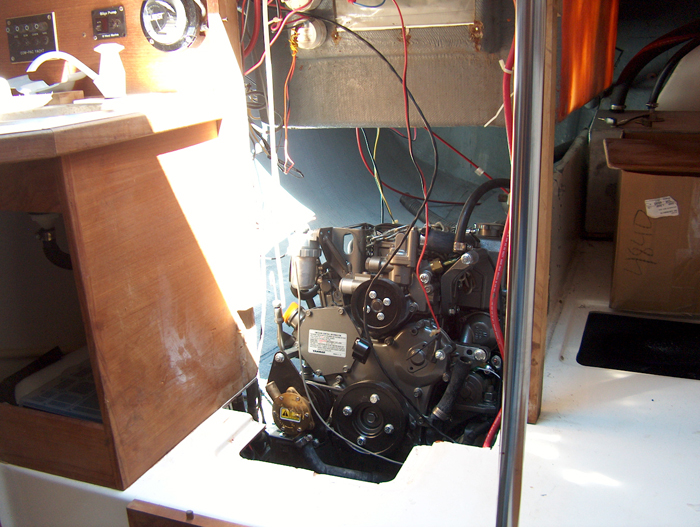
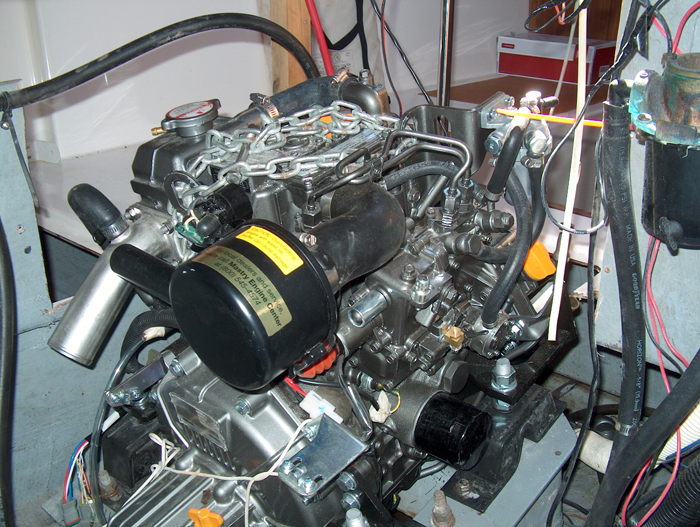
|
We have been doing lots of diesel work lately. Some repairs and some replacements. The engines in the picture below all have a different story to tell. I bet most of you can pick out what going on by just looking at the engines. One 30hp engine is being stored. Another engine is a brand new Yanmar 2YM15. Another engine has been repaired and is waiting for a test run. The last engine is broken, but will be repaired some day soon. Can you figure out which one is which?
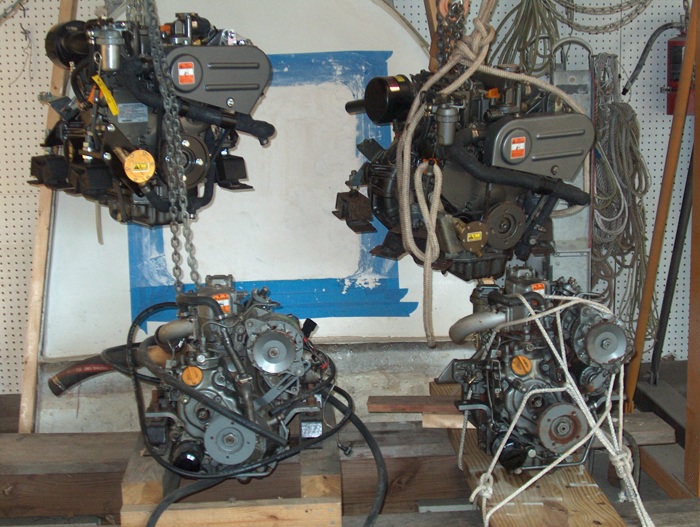
|
My yard has more trawler and pilothouse boats than ever before. We have two Nimble Kodiaks and several modified Com-Pacs. It makes me want to pack my bags and get ready for a cruise down the ICW. One Nimble has shoal draft and a diesel motor and it was designed as a trawler. Putting a mast and sails on that boat should be easy. It already has a refrigerator, chart table and a private head. All these small boats are limited to two people cruising. More people for day sailing will work fine. Some are sold and some are not and they all need work. The boats that are sold need to be ready for the summer. We need to get busy.
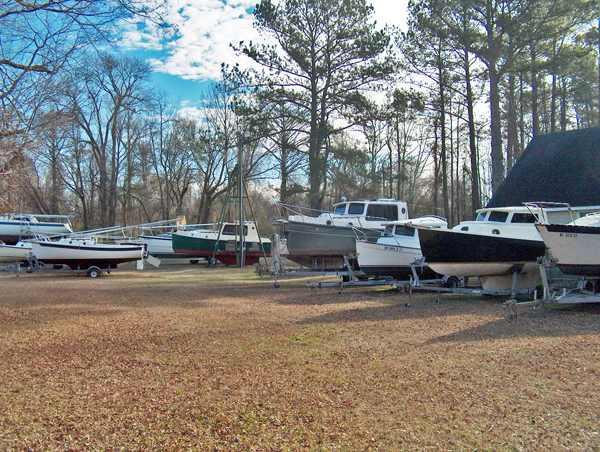
|
The new Horizon Cat rig on my Clark Mills' Sun Cat is doing well. The boat has good cockpit room with the mast down and we plan on making the mast more horizontal by raising the boom gallows another 2 inches. We still have to bottom paint, finish the engine repairs and rig the mast. When that's done, it will be time to go sailing and test the engine and the sail plan.
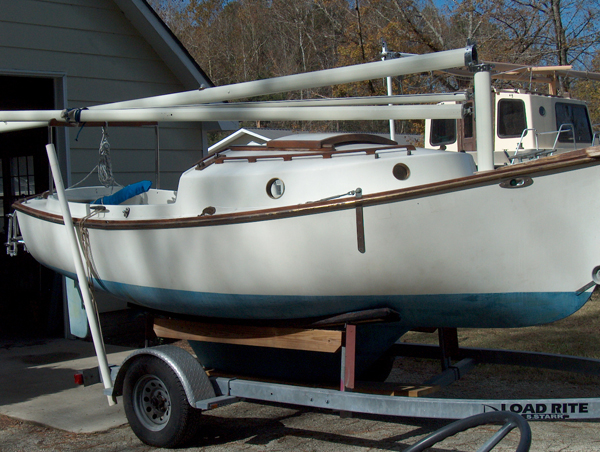
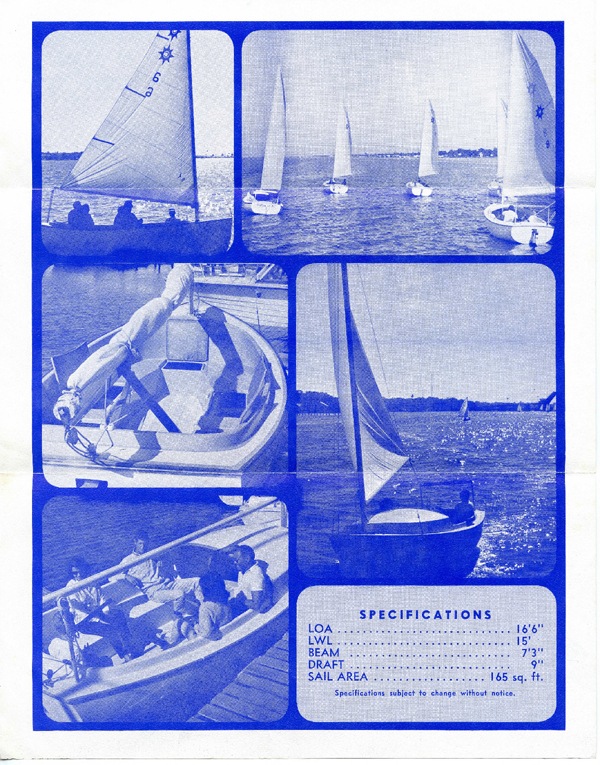
|
Many sailors might not know that a Com-Pac 23 mast and a Horizon Cat mast are the same mast. The Catboat mast can fold using a hinge and the 23 can't. We are currently doing one of these mast conversions on a Clark Mills' Sun Cat. The Sun Cat's original mast was wood with wood spars. It looked good, but required lots of maintenance and ten men and boy to raise.
The new mast needed to be painted a light tan color to match the traditional look of the original boat. We used a hard automotive "base" paint for color with "clear coat" for a final finish. It looks good and will wear well.
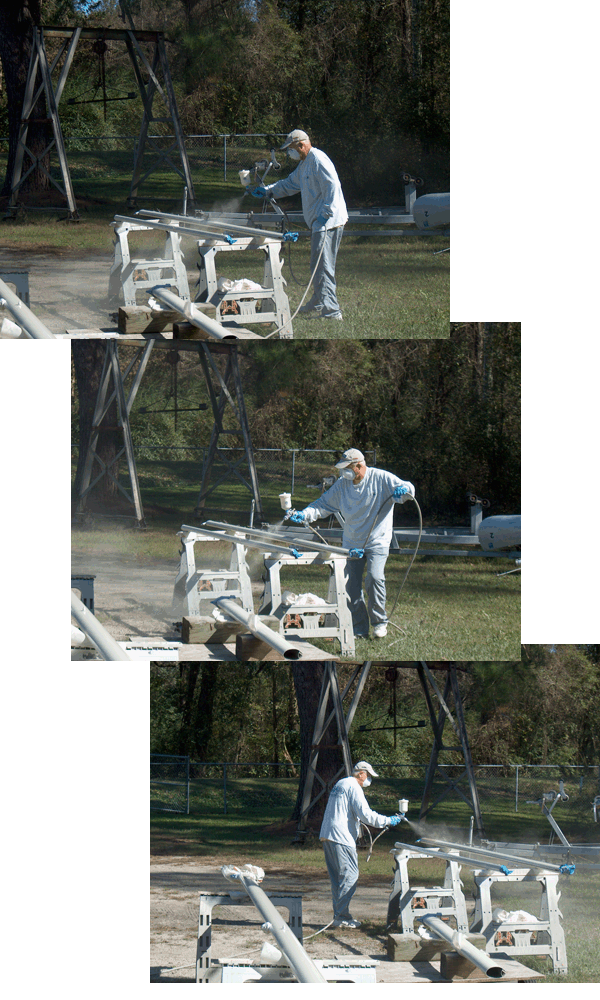
|
Business has been slow this year. Maybe it's the election or it could be the weather was too hot, but two quarters of a low Gross Domestic Product (GDP) are not good for anyone. We have been playing around with some new ideas in our free time and that's always interesting. Com-Pac came up with an improved MasterTender system for some of their boats. I think we can do something similar with a Com-Pac 16. Pulling the mast up with a line and one hand should be an improvement. I have a bridge that I need to motor under and raising the mast on the other side needs to be easy. The trick to doing a 16 is furling gear and a gallows. I think I have all the parts on hand. I owned a Clark Mills Sun Cat back before Com-Pac built Sun Cats and I liked it a lot. It was a keelboat with a Marconi mast. It came out of the same molds that Com-Pac uses today. The bow of a Sun Cat is the same as a Com-Pac 23. I have installed a 23 bowsprit on a Sun Cat before. Perfect fit. Anyway, I have another Clark Mills Sun Cat on the yard. It has a diesel motor and a wood gaff mast and rigging. I think this project is going to have a Horizon Cat MastTender system. The current four-foot bowsprit is going to change to a Horizon Cat bowsprit. The Com-Pac Sun Cat's sail area is modest. A Horizon Cat sail and rig on a Sun Cat that has a diesel should be interesting. If we have too much sail power, we can always reef. We recently came up with a spare diesel motor. I think it will find a home in our San Juan 23. The San Juan is a big shoal draft boat that goes on a trailer well. Add a diesel and an easy up and down mast and the boat should be a great ICW boat. I wonder how many of these projects will get done before business picks up again?
|
When rebuilding or doing major repairs on diesel engines, you need to count the cardboard boxes. You could be a major re-builder or just a small guy in a backyard garage, one engine becomes lots of small parts and pieces when an engine is disassembled. This little used engine had a major problem. The crankshaft was locked in both directions. You could turn the crankshaft nut one turn and it would stop. We called Sherlock Holmes to the rescue and he though the problem was a stuck value. He had seen that problem before. After removing the head, the problem became apparent or almost so. The tappets in the block were stuck and couldn't be moved. They ride on the camshaft and are used to open the valves. How did they get stuck? The head had lots of exhaust residue in the exhaust port. This is not normal. After cleaning the head, a crack could be seen in the exhaust port leading to the push rods and the tappets. The engine was run with the exhaust existing the engine though the tappet area. At some point, the engine didn't run and the engine and boat were laid up for a long period of time.
How did the head malfunction? I'm guessing the engine was run for some time without a cooling water supply. The head got too hot and the cast iron head cracked. I also think the engine was run after the initial cooling system problem was repaired. That's how the exhaust residue accumulated in the exhaust port and tappet area. I'm guessing the little engine ran several hours in this wounded condition. The water pump impellor looked good when we did our inspection.
A solution to this type of problem is to change the water pump impellor every 2 years. And of course, check to make sure water is coming out the transom after starting the engine. Most people get to know the sound or noise their exhaust makes as it comes out the transom. If you think the noise has changed, it is time to check your impellor.
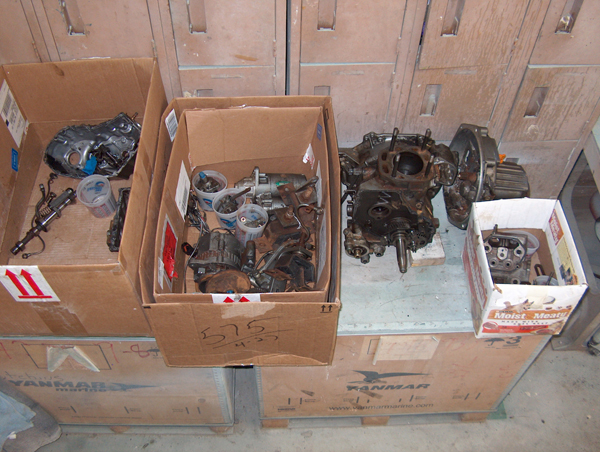
|
Our Project Boat got wet. The boat launched well and everyone at the boat ramp liked its looks. The four-stroke motor ran smooth and quiet. Our camera didn't do that well with the long-range pictures. Sorry about that. The first picture below shows the boat at half throttle, a little bow up and stern down doing about 5 or 6 knots. Can you see the hollow spot in the water between the bow and the stern? That means she was almost at hull speed. The boat felt like a rock and made flat turns. I was pleased with its performance.
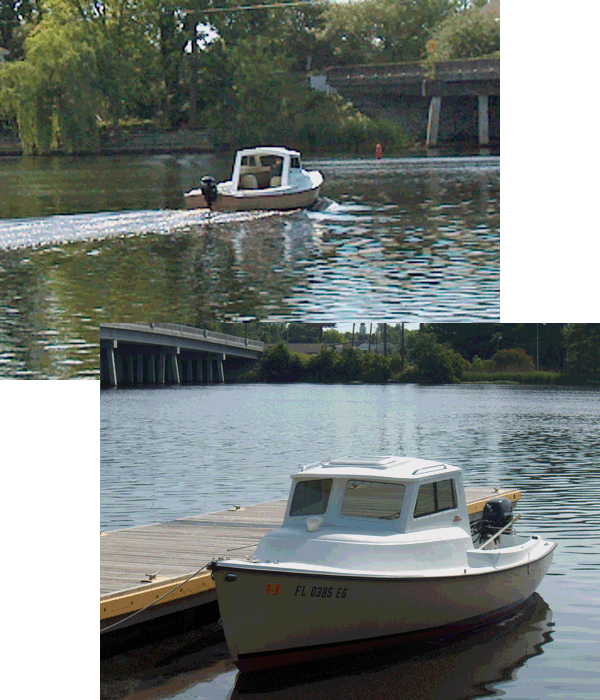
|
The O'Day Sailing Launch has a sail. The design will work like a sailboat with only a mainsail flying. A little weather helm will make for some sweet sailing. The boat will feature a rudder that can operate from either side of the motor. With motor tilted up, the rudder has lots of operating room. The Launch used the boat's original sails and shrouds.
Both inside seats rotate 360 degrees and both have legroom. The big challenge was having walking room between the seats with enough shoulder room higher up. We didn't have any room to spare.
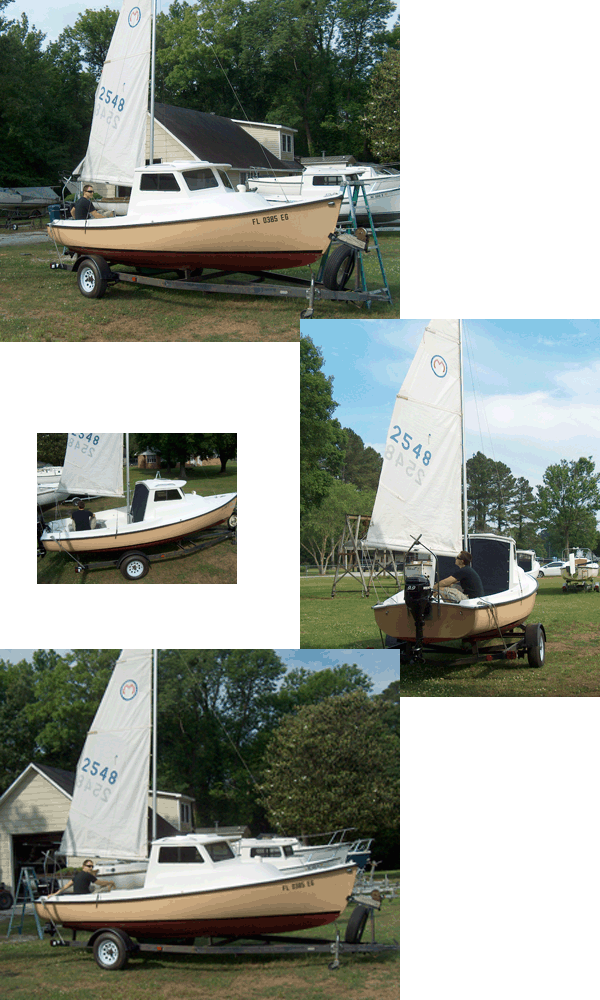
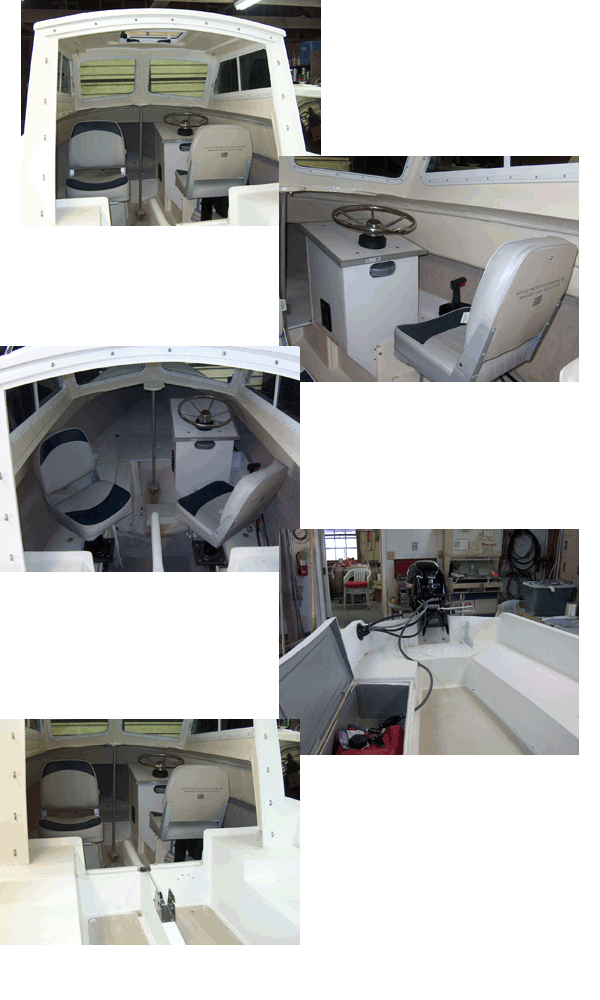
|
Everyone kept saying, put a house on a Com-Pac 19 and make it into a pilothouse. We did and they were right. The house isn't too tall and it goes well with Bob Johnson's basic design. It's going to turn heads and be a definite winner. It looks a little bit like a workboat to me and I like that look. Traditional with a no nonsense look about her. With a big enough motor, she might be able to plane, although I'm not sure why anyone would want to do so. A small, affordable sailboat with inside headroom may be what most people need to travel the highways and see the country. I'm waiting for a Com-Pac Eclipse owner to request an estimate. The house in the bottom picture below doesn't have a visor. I think the visor looks better. What do you think?
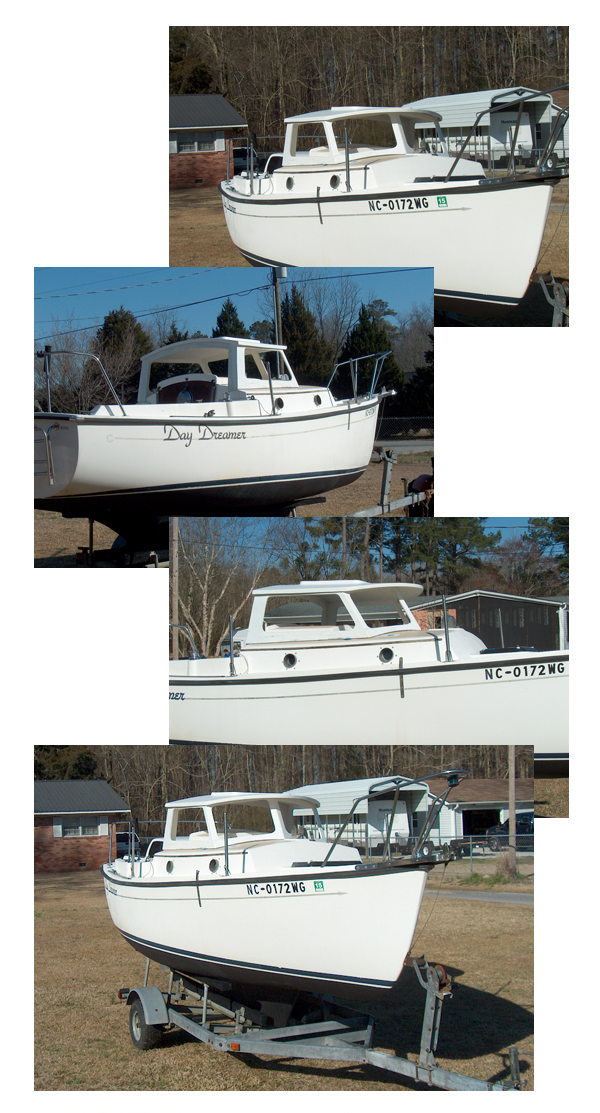
|
We have completed some of the detail work on the O'Day 19. The console and one seat is currently installed and looking good. We have developed a new improved method to cover the epoxy-connecting joint between the house and the boat. It's made with a strip of 3/4-inch aluminum. Picture below. Installing the windows and the housetop will be next with the engine and boot stripe last on our boat list. Then comes the mast, sail and oars.
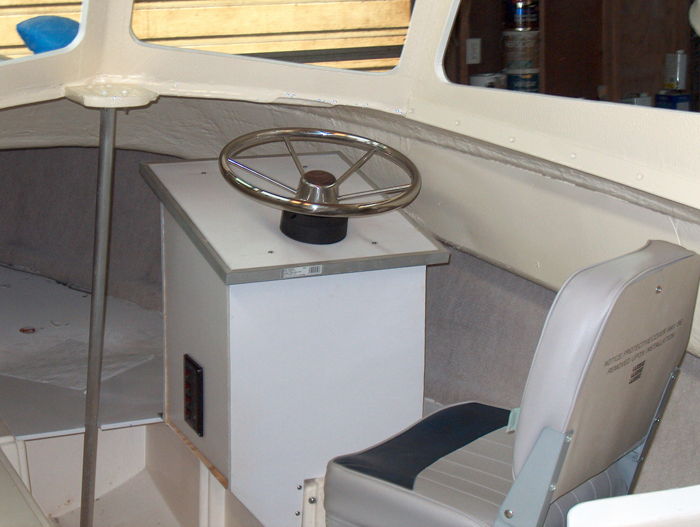
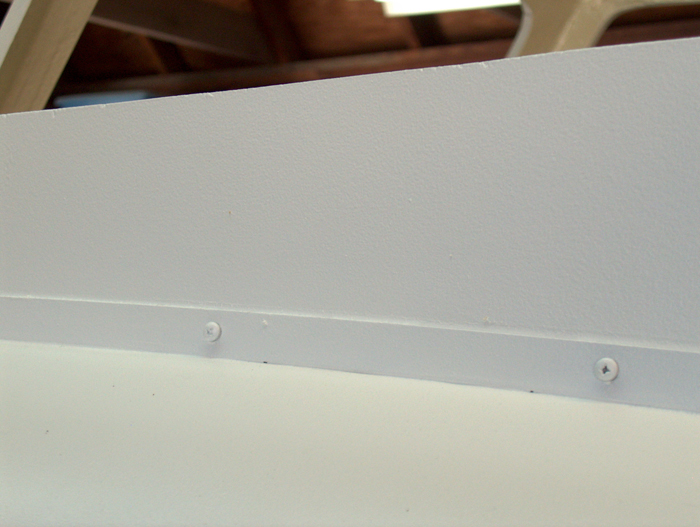
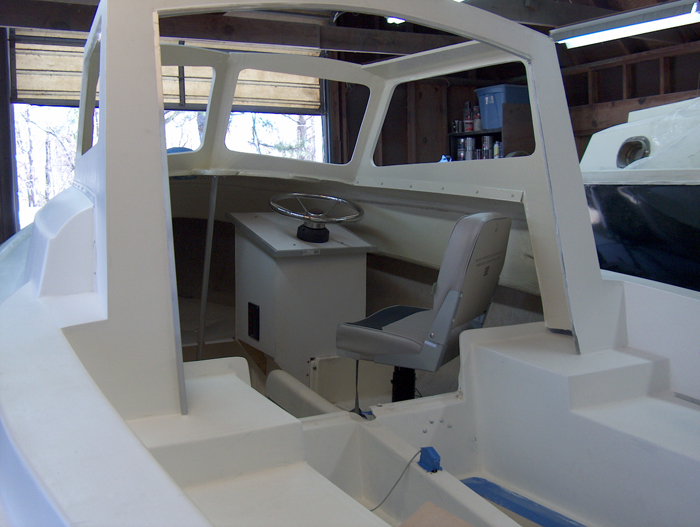
|
We are making some progress on the CP-19 Pilothouse. I have decided to make the boat a basic pilothouse without all the expensive accessories. This boat is going to have a house, taller tabernacle and a boom gallows. The standing headroom is going to be about 5 feet 5 inches. We all bend over a bit when we standup in a standing headroom boat.
We make a generic house that fits most small boats. We use it on the CP-16, O'Day 19 and it is the one we will be using on the CP-19. Most small traditional boats with cabins are very similar in shape. We need to consider where the entrance is going to be and make sure the installed cover at the rear of house will keep water out. The bridge deck and the entrance cover need to work together to keep the boat dry. In some installations, the rear of the house is in the cockpit.
Some of our house customers want to know how we make the bottom edge of the house fit the boat.
The picture below shows our house fitting process. You measure the distance from the house to the deck at the junction between the two front window panels. In this example, it's about 1.5 inches. You reduce the side panel height were the front panels join the side panels by that amount on both sides. Take a slice out of the both side panels. The slice is 1.5 inches at the bow end to zero at the aft end. Blend the front panels bottom curve to match the deck curve. The house being lower in the front by a small amount gives the house a better appearance and reduces the overall height were its not needed.
Another way to fit a house is with the fill method. If all the major points of the house are making contact with the deck, but the curves don't match the deck, a paint paddle can be used to draw new curves. Put the house on the deck with tracing paper over the front window panel. Drag a paint paddle over the window from side to side with one end of the paddle resting on the deck. We drill a hole in the paddle for a pencil. The line on the tracing paper will be the deck curve. Cut a filler piece with the deck curve on one side and the house panel curve on the other. Epoxy together and it s done.
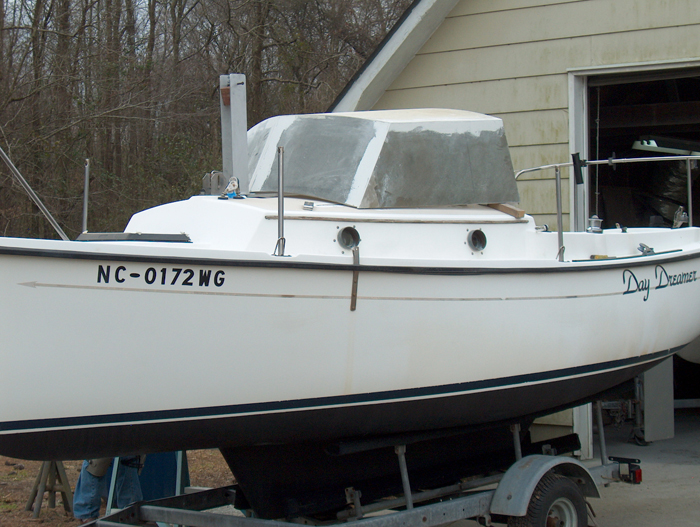
|
The house is attached, but not finished. A new rub rail and black boot stripe will make the boat look really good. The inside is going to have pedestal seats and a cool console with motor controls. A sealed gas hatch has been completed that puts the fuel tank in a secure location that's not in the cockpit. Opening windows and an overhead hatch will provide lots of ventilation. Did I mention the mast and the sail? Maybe next time.
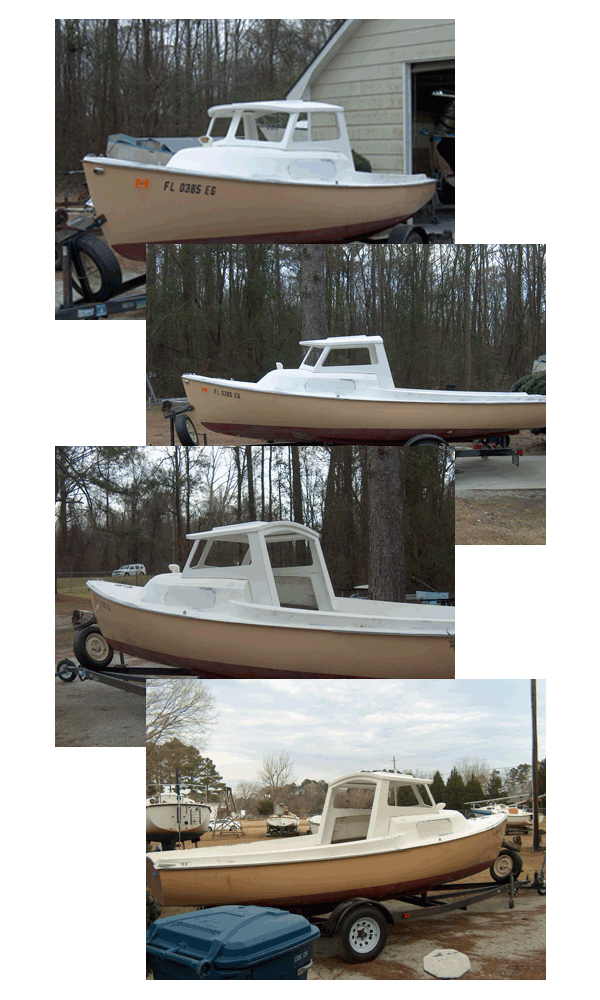
|
We performed major surgery on the O'Day 19 yesterday. We placed the pre-built house in place, marked its location and cut the hole for the house. The hole in the O'Day deck looked huge and everyone wondered if the house was going to cover the hole. Of course, it did as you can see in the third picture below. We believe in measuring twice and cutting one time. This is an O'Day 2 plus 2, or the camper version of the O'Day Mariner Daysailor line. It's going to have opening windows and an overhead hatch. We plan on a small mast in the cockpit and a rudder a little off center on the starboard side.
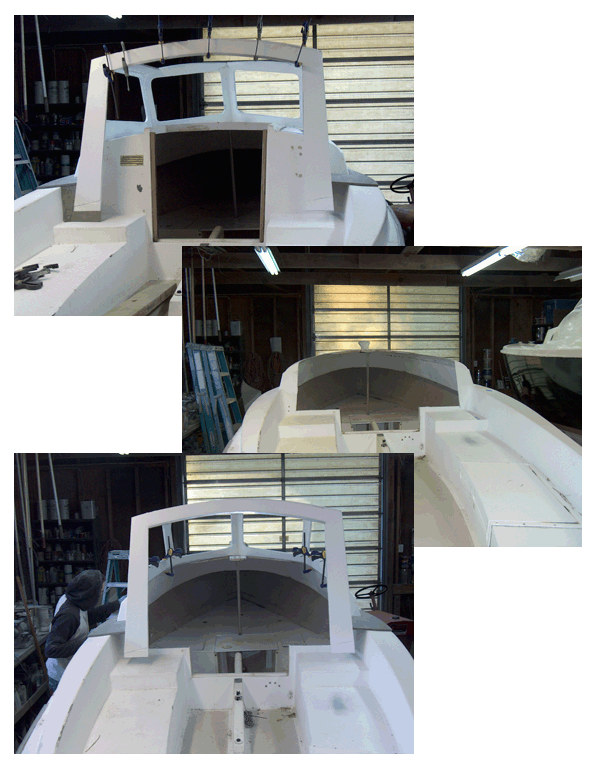
|
Our conversions have a new easy way to a good-looking finish. The industry calls them skins. They are 1/16 inch thick fiberglass with gel-coat on both sides. One side shines and the other is dull. Old boats like the dull look and newer boats or boats that are kept well waxed get the pretty side. COOSA is our product of choice to make our houses. It's light and strong, but hard to finish. This technique is going to save time.
We glue to skins with epoxy and finish the junctions between joints like we would normally repair a crack.
Notice the new inboard rudder on the 23 Trawler. Our stock boats get finished very slowly. We only work on them when we don't have customer boats. Maybe she will get wet this coming summer.

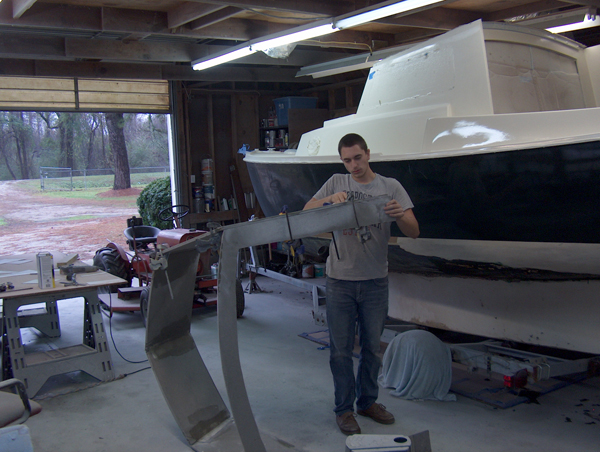
|
|
We decided to make a pilothouse Com-Pac 19. Everyone said it would be a great boat and they were right. This boat is going to have a 9.8 hp remote controlled outboard mounted in middle of the transom. Of course the boat will have a wheel and remote controls in the cabin. The current plan is to steer the boat with a long oar while sailing. That may change, but I don't think so. Additional equipment to make the pilothouse work is a boom gallows and a tall mast tabernacle.
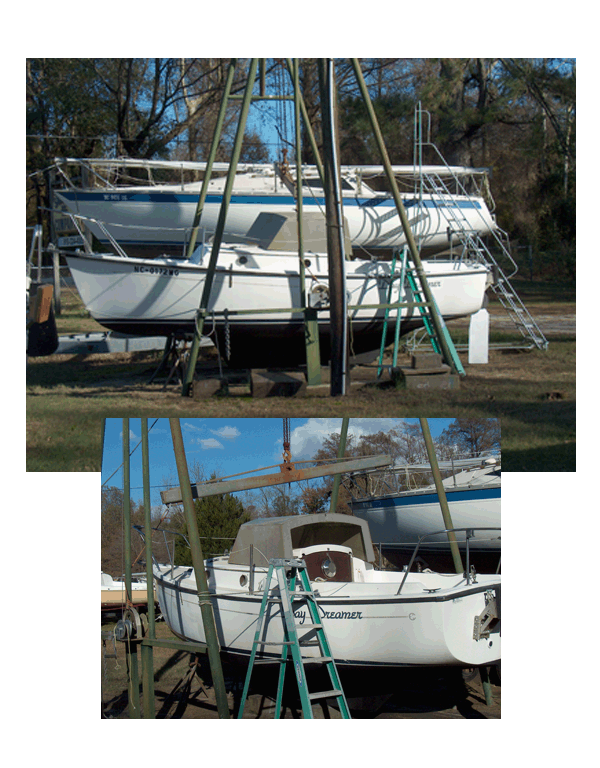
|
We have been thinking about a hard dodger for the Com-Pac 23 and 19. The mockup looks promising and has several different applications. Owner installed with nuts and bolts is one possibility. Bolting the dodger to the deck without cutting the deck would provide a great work area around the original hatch. A second stage of installation could be cutting the deck for more standing headroom down below. Raising the mast by the bow will be satisfactory for boats that live in the water, but trailer-able boats will need more equipment like a different tabernacle and a gallows for mast storage. I think the first one will have fixed ports. The mockup below is sitting on a large 23 cutout. The 19 dodger may go into the bridge deck. The 23 should end at the aft 23-cabin bulkhead.
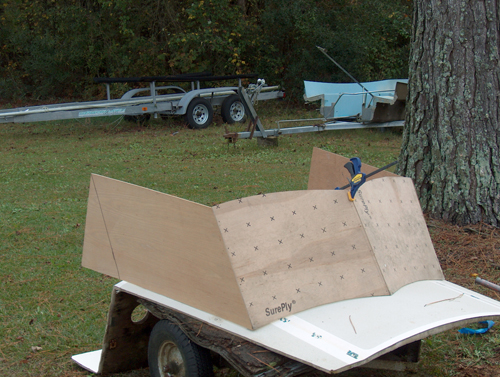
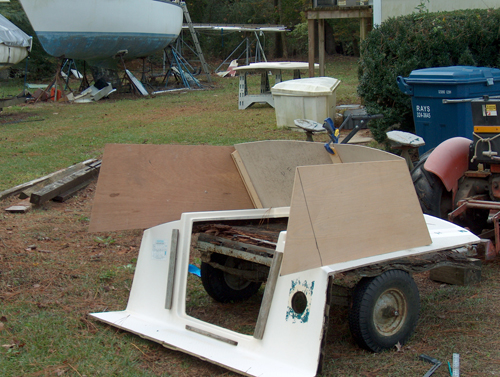
|
The rudder for our 23T is looking good. The blade is only cardbord for now, but the metal shop will finish the project in stainless soon. The boat is going to have a tiller in the cockpit and maybe an optional wheel inside. Docking a small trawler requires a tiller and controls in the cockpit. Docking with a wheel from the cabin single handed doesn't work very well.
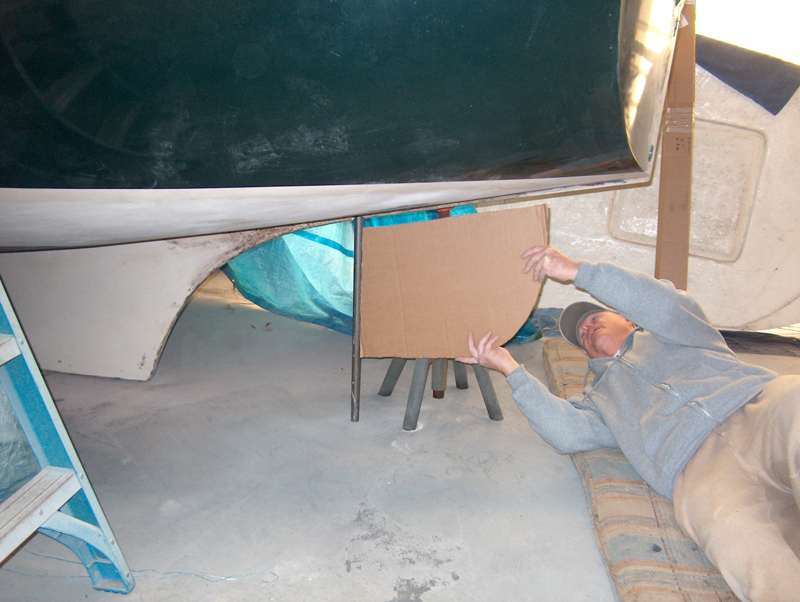
|
We have made some progress on our Com-Pac 23 Trawler. The engine is going to be an outboard for cost reasons. The 9.9hp motor in the picture below is fixed in place and doesn't move to steer the boat. Moving an outboard to steer a boat isn't all that great when you re docking or undocking a boat. This Trawler is going to have an inboard rudder connected to a wheel located in the house. In the Pilothouse version, the rudder could be controlled with a wheel and a tiller.
4 stroke outboards are very reliable and cost about 1/3 of what a diesel installation would cost. A good reason to own an outboard. The downside to having an outboard was the steering problem and that has been solved with an inboard rudder. The price of the inboard rudder is small. An outboard with an inboard rudder cost about 1/2 the cost of a diesel. The EPA says we have to have a fresh water diesel and the smallest one is a 15hp and they cost more than before.
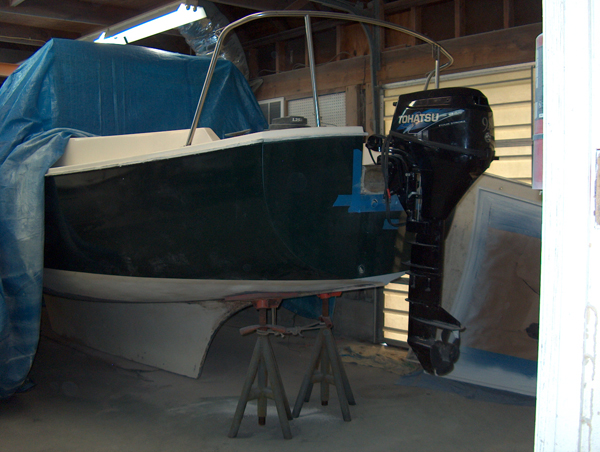
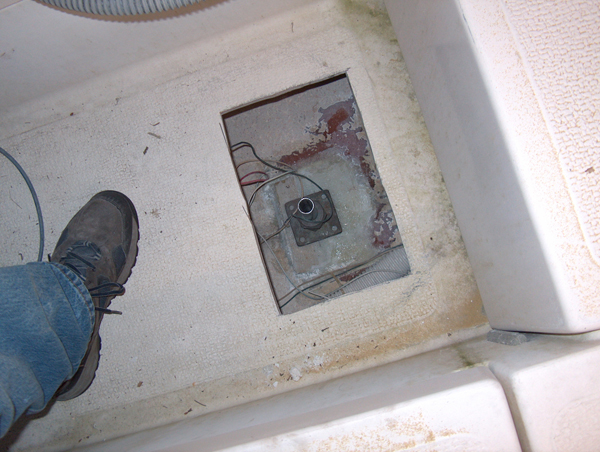
|
I hope everyone had a great Thanksgiving. Between the cold weather and the holidays, we have been busy. We developed a method to put the taller trawler/PH boat on our shop floor. We have 9 feet of clearance between the floor and the roof and the 23 Com-Pac is just over 8 feet tall with the keel flat on the floor. Some of the following pictures show all the light that's available (top/top off) with the boat under a bank of lights. Other trawler/PH boats will have less height than the 23 and they will use the same workspace. We used 2 Harbor Freight cranes, one to pickup the bow and the other to the stern. The nice flat 23 keel sets like a rock on our flat concrete floor.
We finished the Luan mockup for the San Juan/Catalina trawler/PH. The rest of that work will be an outside project and I need warmer weather to get that done. Maybe we will have a heat wave soon?
We have been doing some inside finish work on our Com-Pac 23T. Pictures below. We made a decision to make the boat into a Trawler with an inboard rudder and a center mounted 9.9hp outboard. The logic is in cost and function. Remotely steered outboard motors don't steer that well and the cost of a diesel boat is excessive. Our best compromise is going to be an inboard rudder and a center-mounted outboard.
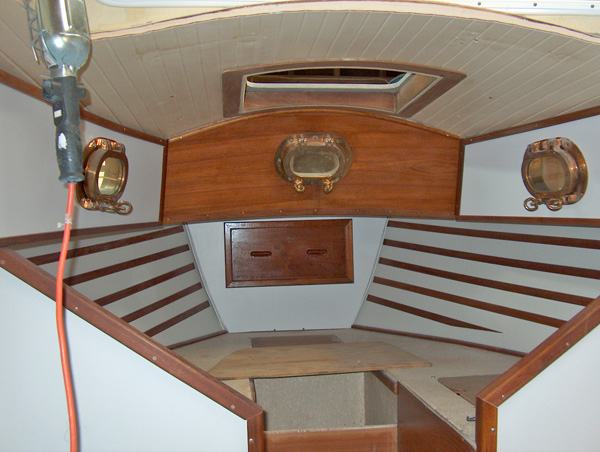
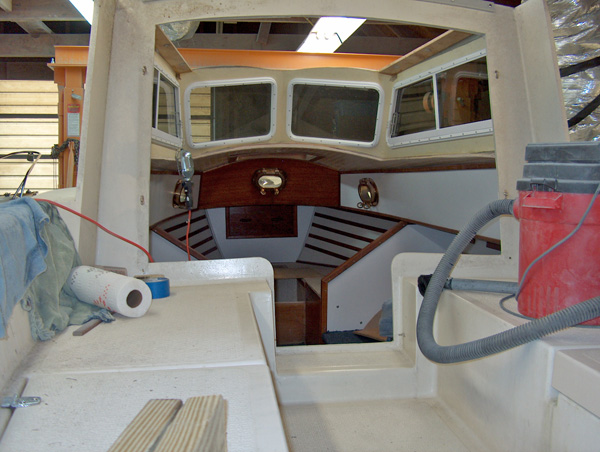
|
We are working on a San Juan 23 Conversion and it looking pretty good. Since this is our first San Juan conversion, we will do a preliminary structure in Lauan plywood first. After that is completed, we will put a top/top on the structure and see how it looks. This boat is large on the inside and it has almost standing headroom without a house. We will decide on trawler/pilothouse gender after we finish the house.

|
Our oarlocks got installed and they turned out well. We used stainless steel tubing and epoxy for the installation. The tubing that's showing on the outside goes all the way down to the bunks. The tubing is epoxied inside the deck on top and to the hull just above the bunks. We used the old trick of putting 7/8 inch tubing inside 1 inch for an adjustable and easy fit. The commercial oarlock at the top is also epoxied into a removable 7/8-inch tube that doesn't leak water. The oars can be used sitting down facing aft with your butt on the bridge deck or standing up facing forward.
We waxed a paint stick to stuff wet epoxy glass up pass the foam in the combing to deck level. The glass at the bottom and top makes for a strong oarlock.
We plan on doing sea trials soon.
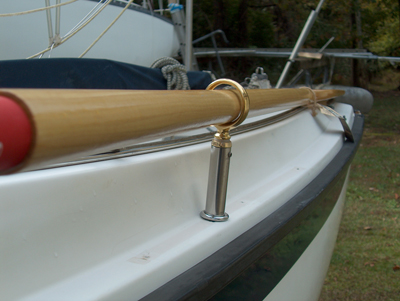
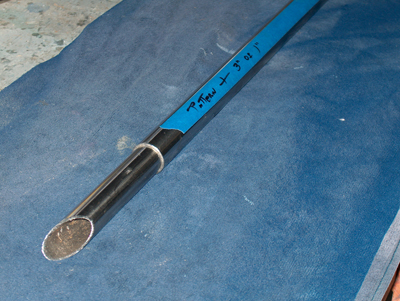
|
Three Projects: Our 82 Com-Pac 23 Mark I has been upgraded recently. The Sailboat Company sold this boat new in 1982 to a good owner and I'm guessing several other owners sense then. It's in great shape and we just installed stainless pulpits, stanchions and a bowsprit. We also installed a Yanmar 8 hp diesel. The boat is going to have furling and I think I will need to sail it some. All restorations need to be thoroughly tested and someone will have to volunteer for that job, as soon it gets warm.
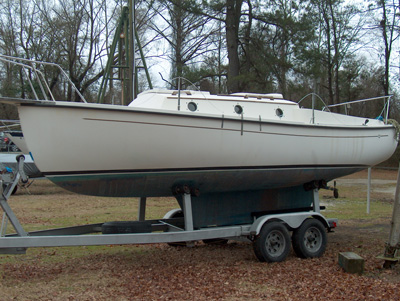
We painted a canoe with that hard AWLCRAFT paint. It's looking good.

The O'Day Launch is coming along. The ballast is in the boat and most of the inside is finished.
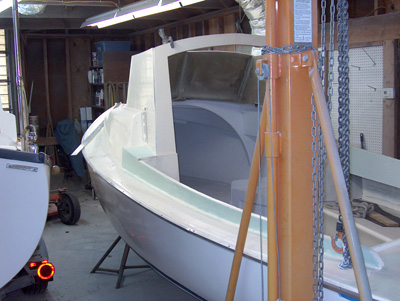
|
O'Day Assembled: We still have the windows, bottom paint and rub rail to install. The inside will require some time for the detail work and our outboard motor mount also has to be installed. The boat's displacement is going to be about 1100 pounds we will be looking for a suitable trailer for this boat. Notice the similar house details between the O'Day and the Com-Pac 16 in the picture. One size fits all in small sailboats?
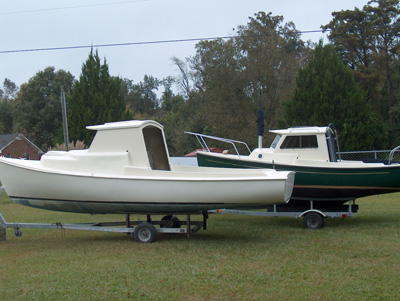
|
Project Painting Parts: The cure time between coats can be as long as 24 hours with some paints and with some other, as long as 2 weeks. If you paint the second coat too soon, the first coat will cause chemical popping (bumps) or what looks like orange peel in the second coat. Our 23T has a pretty cream color for the deck and a dark green for the hull.
The brown streaks on the hull are a reflection from the brown paper below.
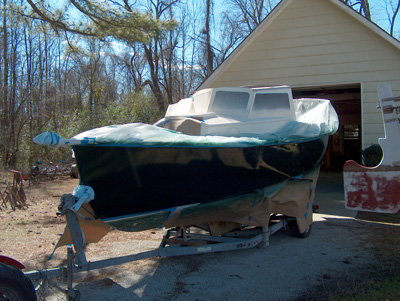
|
Project Com-Pac 23T Interior: The basic inside layout has been completed. The head will be under the forward bunks like the standard boat. The helm console is going to be on the starboard side with the helm seat behind the console. The first mate will be riding on the port side with the chart/dinner table on that side. The space behind the pedestal seats will be a large storage area with a short bulkhead to keep the stored items in place. The pedestal seats will spin in all directions. The boat can be steered while the helm's person is resting in a large comfortable seat. Can we sleep and steer at the same time?
The boat has more than 6 feet of standing headroom in the main cabin with normal sitting headroom in the forward cabin. The Mark II bookcases on each side of the main have been retained. The engine controls will be mounted on/in the starboard bookcase.
The dark green hull color is really pretty. We have 4 coats of paint on the transom and that give it a color that has lots of depth. It may be too pretty.
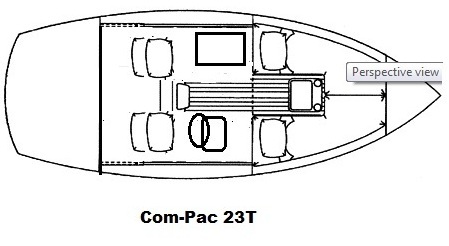
|
Project O'Day Launch: I have had several questions about making sailboats into powerboats. Picking the right sailboat and making the right modifications can be straightforward. We recently decided that a 19-foot O'Day would work just fine. I'm thinking a red hull is going to be a very pretty boat. I also like the plumb bow and the traditional looks of this old O'Day Mariner.
The O'Day pictured below is built like a tank. It has really great glass with no wood coring in the deck to go bad. This boat had a fixed keel that didn't help launching it from a trailer. Other than that shortcoming, it was a great sailboat with the right amount of ballast to sail well. The centerboard version with internal ballast was a more popular boat that you could get on and off a trailer. This project is going to be general restoration and modification to power. The boat will have ballast, no keel and a semi-tall house. Its smooth wide bottom means it's going to plane with a small outboard motor (maybe 15 hp). Getting it on and off the trailer should be easy. The house will provide 5 foot 10 inches of standing headroom and look good to boot. Building cost should be modest.
The hull has the strength to hold about 250 pounds of concrete. We plan on laying the concrete over the area where the old keel was removed. That will maintain the boat's balance. The house will be made from COOSA board that's a man-made foam and fiberglass panel. It has the strength of plywood without the water problems associated with wood. Spraying the panels with a high fill primer will make them smooth enough for an excellent paint job. This is quick and cost effective. This boat will also have fixed windows to keep cost down. The old port will be filled in. I haven't decided yet on adding a small round port on each side for the forward cabin. Making changes as you build is normal. I have made a few changes to the O'Day that are not included in the picture below.
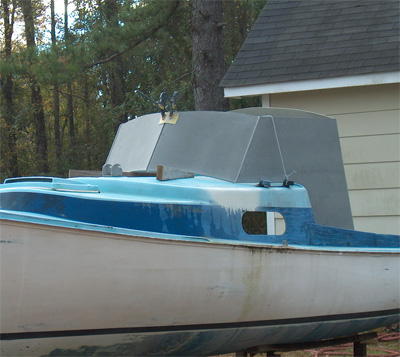
|
Project Com-Pac 23T: The pictures below show the ports and the joint between the house and the deck. The joint treatment turned out well. The technician that did the work said he used his middle finger as a tool. The steering console has been built and the other inside furniture is on hand. We will start painting in about 2 or 3 weeks.
I said in my last installment that the pilothouse would cost about the same as the trawler. That's not true because the pilothouse needs an outboard for power (to keep the cost down) and you can't steer with an outboard while sailing. A rudder will be required to sail the pilothouse version from the cockpit. A rudder needs to be installed in the cockpit floor in front of the motor. It could be the other way around, but outboards don't do well when they live in the water all the time. The rudder behind the keel should work well and it can be fixed. The inside steering station will steer the outboard.

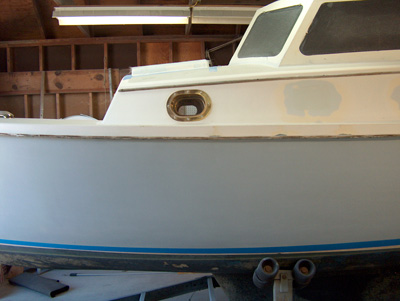
|
|
